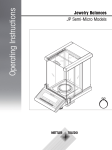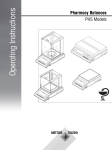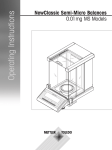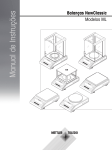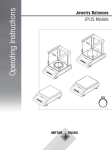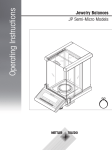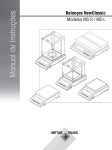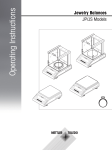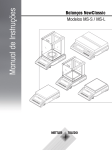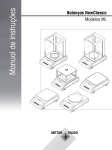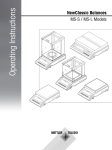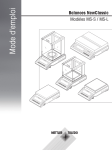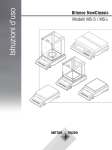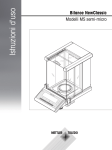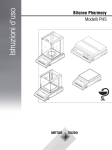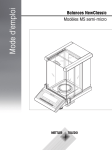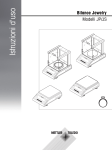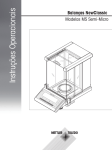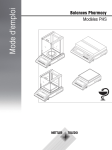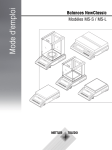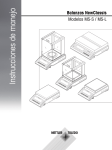Download Operating Instructions Jewelry Balances Models JP12002G
Transcript
Operating Instructions Jewelry Balances Models JP12002G, JP16001G, JP32001G C Table of Contents 1 Introduction 1.1 7 Conventions and Symbols Used in These Operating Instructions 7 2 Safety Precautions 8 3 Overview 9 3.1 3.2 3.3 3.4 4 Setting up the Balance 4.1 4.2 4.3 4.3.1 4.3.2 4.4 4.5 4.6 4.7 4.7.1 4.7.2 4.8 4.8.1 4.8.2 4.8.3 4.8.4 5 9 9 10 11 13 Unpacking and Delivery Inspection Installing the Components Selecting the Location and Leveling the Balance Selecting the Location Leveling the Balance Power Supply Transporting the Balance Weighing Below the Balance General Requirements Switching on the Balance Adjusting the Balance Adjustment (Calibration) Fully Automatic Adjustment FACT Manual Adjustment with Internal Weight Manual Adjustment with External Weight Customer Fine Adjustment Weighing Made Simple 5.1 5.2 5.3 5.4 5.5 5.6 5.7 6 JP12002G JP16001G, JP32001G Operation Keys Display Panel Switching the Balance On and Off Performing a Simple Weighing Zero Setting Switching Weight Units Recall / Recall Weight Value Weighing with the Weighing-in Aid Print / Transmit Data The Menu 13 13 14 14 14 15 15 16 16 16 16 17 17 17 17 18 20 20 21 21 21 21 22 22 23 6.1 6.2 6.3 6.3.1 6.3.2 6.3.3 6.3.4 What is in the Menu ? Menu Operation Description of Menu Topics Main Menu Basic Menu Advanced Menu Interface Menu 23 24 25 25 26 27 31 Table of Contents 3 7 Applications 7.1 7.2 7.3 7.4 7.5 7.6 7.7 7.8 7.8.1 7.8.2 7.8.3 7.9 7.10 7.10.1 7.10.2 7.10.3 7.10.4 7.10.5 7.10.6 7.10.7 7.10.8 8 Operating Principle Update Procedure 39 42 44 47 49 51 53 55 55 57 58 61 64 64 65 66 67 67 68 69 70 71 71 72 74 74 74 Error and Status Messages 76 10.1 10.2 76 77 Error Messages Status Messages 11 Cleaning and Service 78 12 Interface Specification 79 12.1 12.2 12.3 13 Table of Contents RS232C Interface USB Device Interface MT-SICS Interface Commands and Functions Technical Data 13.1 13.2 13.3 13.3.1 13.3.2 4 Function PC-Direct USB Device Interface Firmware (Software) Updates 9.1 9.2 10 Application "Piece Counting" Application "Percent Weighing" Application "Check Weighing" Application "Statistics" Application "Totaling" Application "Multiplication Factor Weighing" Application "Division Factor Weighing" Application "Density" Density Determination of Solids Density Determination of Liquids Formulae Used to Calculate Density Application "Routine Test" Application "Diagnostics" Repeatability Test Display Test Key Test Motor Test Balance History Calibration History Balance Information Service Provider Information Communication with Peripheral Devices 8.1 8.2 9 39 79 79 80 81 General Data Model-Specific Data Dimensions JP12002 JP16001G, JP32001G 81 82 83 83 84 14 Accseeories and Spare Parts 14.1 14.2 Index Accessories Spare Parts 85 85 88 89 Table of Contents 5 1 Introduction Thank you for choosing a METTLER TOLEDO balance. The precision balances of the Jewelry line combine a large number of weighing possibilities with easy opera tion. These operating instructions ● apply to all balance models JP12002G, JP16001G and JP32001G in the Jewelry line. ● are based on the initially installed firmware (software) version V2.20. Please observe the following notes: Some illustrations in these operating instructions are based on MS-S/MS-L models. They therefore might differ in some cases. However, functionality is not affected. 1.1 Conventions and Symbols Used in These Operating Instructions Key designations are indicated by double angular brackets (e.g. « »). This symbol indicates press key briefly (less than 1.5 s). This symbol indicates press and hold key down (longer than 1.5 s). This symbol indicates a flashing display. This symbol indicates an automatic sequence. These symbols indicate safety notes and hazard warnings which, if ignored, can cause per sonal danger to the user, damage to the balance or other equipment, or malfunctioning of the balance. This symbol indicates additional information and notes. These make working with your bal ance easier, as well as ensuring that you use it correctly and economically. Introduction 7 2 Safety Precautions Always operate and use your balance only in accordance with the instructions contained in this manual. The instructions for setting up your new balance must be strictly observed. If the balance is not used according to these Operating Instructions, protection of the balance may be impaired and METTLER TOLEDO assumes no liability. It is not permitted to use the balance in explosive atmosphere of gases, steam, fog, dust and flammable dust (hazardous environments). For use only in dry interior rooms. Do not use sharply pointed objects to operate the keyboard of your balance! Although your balance is very ruggedly constructed, it is nevertheless a precision instrument. Treat it with corresponding care. Do not open the balance: It does not contain any parts which can be maintained, repaired, or replaced by the user. If you ever have problems with your balance, contact your METTLER TOLEDO dealer. Use only balance accessories and peripheral devices from METTLER TOLEDO; they are opti mally adapted to your balance. Use only the original universal AC adapter delivered with your balance. Disposal In conformance with the European Directive 2002/96/EC on Waste Electrical and Electronic Equipment (WEEE) this device may not be disposed of in domestic waste. This also applies to countries outside the EU, per their specific requirements. Please dispose of this product in accordance with local regulations at the collecting point specified for electrical and electronic equipment. If you have any questions, please contact the responsible authority or the distributor from which you purchased this device. Should this device be passed on to other parties (for private or professional use), the content of this regu lation must also be related. Thank you for your contribution to environmental protection. 8 Introduction 3 Overview 3.1 JP12002G 7 6 8 13 5 C 9 1 2 10 11 12 3 4 Name and Function of Components 1 Display 2 Operation keys 3 Model sticker (with approved models only) 4 Leveling feet 5 Safety feet 6 Draft shield element 7 Weighing pan 8 9 10 11 12 13 Level indicator USB device interface RS232C serial interface Socket for AC Adapter Kensington slot for anti-theft purposes Product label 3.2 JP16001G, JP32001G 3 4 5 1 10 2 5 Overview 9 9 11 6 5 7 8 Name and Function of Components 1 Display 2 Operation keys 3 Weighing pan 4 Level indicator 5 Leveling foot 6 USB device interface 7 8 9 10 11 5 RS232C serial interface Power cord with country-specific plug Security slot for anti-theft purposes Model sticker (with approved models only) Product label 3.3 Operation Keys 1 2 3 4 C 5 Key Functions No. Key 1 6 9 7 Press briefly (less than 1.5 s) ● To change display resolution (1/10d 10 Press and hold (longer than 1.5 s) no function function) while application is running Note: not available with approved mod els in selected countries. 2 ● Enter or leave menu (Parameter settings) no function ● Save parameters 3 ● Execute predefined adjusting (calibration) no function procedure 10 Overview 8 No. 4 Key Press briefly (less than 1.5 s) ● Printout display value Press and hold (longer than 1.5 s) no function ● Printout active user menu settings ● Transfer data ● To navigate back (scroll up) within menu ● To select the weighing application 5 6 topics or menu selections ● Decrease (numerical) parameters within menu and in applications ● Decrease (numerical) parameters quickly ● To navigate forward (scroll down) within ● To select assigned F1 application and menu topics or menu selections ● Increase (numerical) parameters within menu and in applications 7 9 entering the parameter settings of appli cation. ● Default F1 application assignment: Piece counting ● Increase (numerical) parameters quickly within menu and in applications ● With entries: scroll down ● To select assigned F2 application and ● To navigate through menu topics or entering the parameter settings of appli cation. ● Default F2 application assignment: Per cent weighing menu selections ● To toggle between unit 1, recall value (if selected), unit 2 (if different from unit 1) and the application unit (if any) 8 within menu and in applications ● To enter or leave menu selection (from / ● To select assigned F3 application and to menu topic) ● To enter application parameter or switch to next parameter ● To confirm parameter entering the parameter settings of appli cation. ● Default F3 application assignment: For mulation ● Switch on ● Switch off ● Zero ● Cancel and to leave menu without saving no function 10 (one step back in the menu). 3.4 Display Panel Status Icons Unit Field Weight Value Field Application Icons Weighing-in aid Application Icons Menu locked Menu setting activated Status Icons Application "Statistics" Application “Totaling” Overview 11 Application Icons Application "Weighing" Application “Multiplication factor” Application "Piece counting" Application “Division factor” Application "Percent weighing" Application “Density” Application "Check weighing" Note While an application is running, the corresponding application icon appears at the top of the display. Status Icons Indicates stored value (Memory) Service reminder Adjustments (calibration) started Acoustic feedback for pressed keys activated FACT activated Weighing range 1 (Dual Range models only) Applications "Diagnostics" and “Routine Test” Weighing range 2 (Dual Range models only) Weight Value Field and Weighing-in aid Indicates negative values Brackets to indicate uncertified digits (approved models only) Indicates unstable values Marking of nominal or target weight Indicates calculated values Marking of tolerance limit T+ Marking of tolerance limit T- Unit Field g kg mg ct lb oz 12 Overview gram kilogram milligram carat pound ounce ozt GN dwt mom msg tlh troy ounce grain pennyweight momme mesghal Hong Kong taels tls tlt tola baht Singapore taels Taiwan taels tola baht 4 Setting up the Balance The balance must be disconnected from the power supply when carrying out all setup and mounting work. 4.1 Unpacking and Delivery Inspection 1 Open the packaging and carefully remove all components. 2 Check the delivered items. The standard scope of delivery contains the following items: JP12002G ● Weighing pan 170 x 200 mm ● Draft shield element ● Pan support ● Protective cover ● Universal AC adapter (country specific) ● Operating instructions printed or on CD-ROM depending on the country ● Quick Guide ● EC declaration of conformity JP16001G, JP32001G ● Weighing pan 246 x 351 mm ● Protective cover ● Mounted country specific power cable ● Operating instructions printed or on CD-ROM depending on the country ● Quick Guide ● EC declaration of conformity 4.2 Installing the Components JP12002G – Place the following components on the balance in the specified order: 3 ● Pan support (1) ● Weighing pan (2) 2 ● Draft shield element (3) 1 C Setting up the Balance 13 JP16001G, JP32001G – Place the weighing pan (1) on the balance. 1 4.3 Selecting the Location and Leveling the Balance Your balance is a precision instrument and will thank you for an optimum location with high accuracy and dependability. 4.3.1 Selecting the Location Select a stable, vibration-free position that is as horizontal as possible. The surface must be able to safely carry the weight of a fully loaded balance. Observe ambient conditions (see Technical Data). Avoid the following: ● Direct sunlight ● Powerful drafts (e.g. from fans or air conditioners) ● Excessive temperature fluctuations 4.3.2 Leveling the Balance The balances have a level indicator and two (JP12002G) or four (JP16001G, JP36001G) adjustable leveling feet to compensate for slight irregularities in the surface of the weighing bench. The balance is exactly horizontal when the air bubble is in the middle of the level glass. – Align the balance horizontally by turning the leveling screws of the balance housing until the air bubble is in the inner circle of the lev el indicator. Note: The balance should be leveled and adjusted each time it is moved to a new location. 14 Setting up the Balance JP12002G A 1 Remove the clamps (A) for the safety feet by turning them out wards. Note: Turn the clamps (A) outwards as far as they will go (~ 90°), so that the safety feet can move freely. A 2 Now level the balance by turning both leveling screws (B) until the air bubble is in the inner circle of the level indicator (see procedure above). B B 3 Secure the safety feet by turning the clamps (A) inwards as far as they will go. C 4.4 Power Supply Your balance is supplied with a country-specific AC adapter or with a country-specific power cable. The power supply is suitable for all line voltages in the range: 100 - 240 VAC, 50/60 Hz (for exact specifications, see section "technical data"). First, check the local line voltage is in the range 100 - 240 VAC, 50/60 Hz and whether the power plug fits your local power supply connection. If this is not the case, on no account connect the balance to the power supply, but contact the responsible METTLER TOLEDO dealer. Important: ● Before operating, check all cables for damage. ● Guide the cables so that they cannot become damaged or interfere with the weighing process! ● Take care that the AC adapter cannot come into contact with liquids! ● The power plug must be always accessible. Allow your balance to warm up for 30 minutes to enable it to adapt itself to the ambient conditions. JP12002G Connect the AC adapter to the connection socket on the back of your balance (see figure) and to the mains. 4.5 Transporting the Balance Switch off the balance and remove the power cable and any interface cable from the balance. Refer to the notes in Section "Selecting the location" regarding the choice of an optimal location. Setting up the Balance 15 Transporting Over Long Distances If you would like to transport or send your balance over long distances, use the complete original packaging. 4.6 Weighing Below the Balance The balances are equipped with a hanger for carrying out weighings below the work surface (weighing below the balance). Note: For below-the-balance weighing with JP16001G and JP32001G, you will need hook 11132565 from the accessories range. JP12002G JP16001G, JP32001G A B A B 1 Switch off the balance and remove the power cable and any interface cable from the balance. 2 Remove the weighing pan, pan support and draft shield element if present. 3 Turn the balance carefuly on its side. 4 Remove and retain the 2 screws (A) and the cover plate (B). The position for the hanger is now accessible. 5 Screw on the hook if needed. 6 Then turn the balance to its normal position and simply reinstall all components in the reverse order. 4.7 General Requirements 4.7.1 Switching on the Balance Before working with the balance, it must be warmed up in order to obtain accurate weighing results. To reach operating temperature, the balance must be connected to the power supply for at least ● 30 minutes on balances with a readability of 0.001 g (0.01 ct) to 5 g. 4.7.2 Adjusting the Balance To obtain accurate weighing results, the balance must be adjusted to match the gravitational acceleration at its location and depending on the ambient conditions. After reaching the operation temperature, adjusting is neces sary ● before the balance is used for the first time. ● after a change of the location. ● at regular intervals during weighing service. See also ● Switching on the Balance (page 16) 16 Setting up the Balance 4.8 Adjustment (Calibration) Attention Before adjusting the balance, it must be warmed up. 4.8.1 Fully Automatic Adjustment FACT The factory setting is fully automatic adjustment FACT (Fully Automatic Calibration Technology) with the inter nal weight (see also section "The Menu"). The balance adjusts itself automatically: ● after the warm-up phase on connection to the power supply. ● when a change in the ambient conditions, e.g. the temperature, could lead to a noticeable deviation in the measurement. ● on a predefined time. (see menu topic "FACT") ● time interval. (with OIML accuracy class II approved models) 4.8.2 Manual Adjustment with Internal Weight Requirement: To carry out this operation, in the menu topic "CAL" (Adjustment) of advanced menu "ADJ.INT" must be selected. ADJ.INT 1 Unload weighing pan ------ 2 Press « » to execute "Internal Adjustment". ADJ DONE 0.00 The balance adjusts itself automatically. The adjusting is finished when the message "ADJ DONE" appears briefly on the display. The balance returns to the last active application and is ready for operation. g Sample adjustment printout using internal weight: - Internal Adjustment -21.Jan 2009 12:56 METTLER TOLEDO Balance Type SNR Temperature Diff MS4002S 1234567890 22.5 °C 3 ppm Adjustment done ----------------------- 4.8.3 Manual Adjustment with External Weight Note: Because of certification legislation, the approved models cannot be adjusted with an external weight (depend on selected countries' certification legislation). Setting up the Balance 17 Requirement: To carry out this operation, in the menu topic "CAL" (Adjustment) of advanced menu "ADJ.EXT" must be selected. ADJ.EXT 2000. 00 g Note We recommend to disable FACT. 1 Have required adjustment weight ready. C -----0. 00 3 Press « » briefly to execute "External Adjustment". The required (predefined) adjustment weight value flashes on the display. g ------ C ADJ DONE 0. 00 2 Unload weighing pan. g 4 Place adjustment weight in center of pan. The balance adjusts itself automatically. 5 When "0.00 g" flashes, remove adjustment weight. The adjusting is finished when the message "ADJ DONE" appears briefly on the display. The balance returns to the last active application and is ready for operation. Sample adjustment printout using external weight: - External Adjustment -21.Jan 2009 12:56 METTLER TOLEDO Balance Type SNR MS4002S 1234567890 Temperature Nominal Actual Diff 22.5 °C 2000.00 g 1999.99 g 5 ppm Adjustment done Signature ....................... ----------------------- 4.8.4 Customer Fine Adjustment Attention This function should be executed only by trained personnel. The function customer fine adjustment "ADJ.CUST.F" allows you to adjust the value of the internal adjustment weight with your own adjustment weight. The adjustable range of the adjustment weight is possible only in a very small range. Customer fine adjustment impacts the function of internal adjustment. The customer fine adjustment can be deactivated at any time. Note ● This feature is available on models with internal weight only. ● Because of certification legislation, approved models cannot be adjusted with customer fine adjustment (depending on selected countries' certification legislation). ● Use certificated weights. 18 Setting up the Balance ● Balance and test weight have to be on operating temperature. ● Observe the correct environmental conditions. Execute customer fine adjustment The balance is under measuring condition. ADVANCED 1 Have required adjustment weight ready. 2 Unload weighing pan 3 Select in the menu "ADVANCED": ADJ.CUST.F ADJ.CUST.F 4 Confirm "ADJ.CUST.F" with « ». 5 To carry out this operation select "EXECUTE" EXECUTE 6 Start Adjustment with « SET REF. » "SET REF." appears briefly. The last saved value flashes on the display. + 200.0000 g 7 Select the target adjustment weight. • For coarse setting, press « » to change the value. • For fine setting, press «+» to increase the value or press "-" to decrease the value. 200.0005 g 8 Press and hold « ------ The required adjustment weight value flashes in the display. This could take some time. 200.0005 g 9 Place required adjustment weight in center of pan. 10 Remove adjustment weight when zero is flashing. C -----0.00 C 11 Wait until "ADJ DONE" briefly appears. The adjusting is finished when the message "ADJ DONE" appears briefly on the display. The balance returns to the last active appli cation and is ready for operation g ------ If the error message "WRONG ADJUSTMENT WEIGHT" appears, the weight is not within the allowed value range and could not be accepted. "ADJ.CUST.F" could not be executed. ADJ.DONE 0.00 » to confirm and execute "ADJ.CUST.F". Note Storing the adjustment is not required. g Deactivate customer fine adjustment 1 Select in the menu "ADVANCE.": "ADJ.CUST.F". 2 Confirm "ADJ.CUST.F" with « ». 3 To carry out this operation select "RESET" 4 Start RESET by pressing « » "NO?" appears. 5 Select "YES?" and confirm with« ». The adjusting is finished when the message "ADJ DONE" appears briefly on the display. The balance returns to the last active application and is ready for operation with initial adjustment. Setting up the Balance 19 5 Weighing Made Simple This section shows you how to perform simple weighings and how you can accelerate the weighing process. 5.1 Switching the Balance On and Off Switching on Connecting to the mains 1 Remove any load from weighing pan. 2 Connect balance via AC adapter to the mains. The balance performs a display test (all segments in the display light up briefly), "WELCOME", Software version, Maximum load and Read ability appears briefly. (Startup "FULL" mode only) 8888888 XXXXXXX 0.00 g After the warm-up time, the balance is ready for weighing or for opera tion with the last active application, see General Requirements. Standby mode On – Press «On». Off 0.00 g The balance is ready for weighing or for operation with the last active application. Approved balances will execute an initial zero. Switching off On Off SHUTOFF – Press and hold the «Off» key until "SHUTOFF" appears on the dis play. Release the key. Balance switches into standby mode. Note: ● After switching on from standby mode, your balance needs no warm-up time and is immediately ready for ● ● ● ● 20 weighing. Standby mode is not possible with approved balances (only available in selected countries). If your balance has been switched off after a preselected time, the display is dimly lit and shows date, time, maximum load and readability. If your balance has been switched off manually, the display is off. To completely switch off mains operated balances, they must be disconnected from the power supply. Setting up the Balance 5.2 Performing a Simple Weighing 1 Press « » to zero the balance. Note: If your balance is not in the weighing mode, press and hold the « » key down until “WEIGHING“ appears in the display. Release the key. Your balance is in the weighing mode and set to zero. 0. 00 # 0. 00 2 Place weighing sample on the weighing pan. 1182. 03 3 Wait until the instability detector " " disappears and the stability beep sounds. ¢¢¢¢¢¢ C 1250.38 4 Read the result. ¢¢¢¢¢¢¢¢ 5.3 Zero Setting 1 Unload the balance. 121.01 g 0.01 g 0.00 g ¢¢¢¢ C # C 2 Press « » to set the balance to zero. All weight values are measured in relation to this zero point (see menu topic "ZERO RNG"). Note: Use the « ing. If you are working with a weighing container, first set the balance to zero. 0.00 g 121.01 g ¢¢¢¢ 1 Place empty container on the weighing pan. The weight is dis played. 2 Press « # 0.00 ¢¢¢¢ » zeroing key before you start with a weigh g » to set the balance to zero. "0.00 g" appears in the display. 3 Place weighing sample into the weighing container. ¢¢¢¢¢¢¢ 95.97 g The result appears in the display. C 5.4 Switching Weight Units ¢¢¢¢ 22. 00 22. 00 * ¢¢¢¢ 0.78 g The « » key can be used at any time to toggle between weight unit "UNIT 1","RECALL" value (if selected) and weight unit "UNIT 2" (if dif ferent from weight unit 1) and the application unit (if any). M g oz 5.5 Recall / Recall Weight Value Recall stores stable weights with an absolute display value bigger than 10d. Requirement: The function "RECALL" must be activated in the menu. Weighing Made Simple 21 C 0. 00 g 121. 01 g ¢¢¢¢ 0. 00 g C 121. 01 M 2 Remove weighing sample. When the weight is removed the Display shows zero. 3 Press « ». The display shows last stored stable weight value for 5 seconds together with asterisk (*) and Memory (M) symbols. After 5 seconds the display goes back to zero. This can be repeat ed unlimited times. g Delete last weight value g As soon a new stable weight value is displayed, the old recall value becomes replaced by the new weight value. When pressing », the recall value is set to 0. « 0. 00 1 Load weighing sample. The display shows weight value and stores stable value. Note: If the power is switched off, the recall value is lost. The recall value can not be printed. 5.6 Weighing with the Weighing-in Aid ¢¢¢¢¢¢¢¢ 0% 100% The weighing-in aid is a dynamic graphic indicator which shows the used amount of the total weighing range. You can thus recognize at a glance when the load on the balance approaches the maximum load. 5.7 Print / Transmit Data Pressing the « » key transmits the weighing results over the interface e.g. to a printer or a PC. 22 Weighing Made Simple 6 The Menu 6.1 What is in the Menu ? The Menu allows you to match your balance to your specific weighing needs. In the menu you can change the settings of your balance and activate functions. The main menu has 4 different menus and these contains 45 different topics, each of which allows you various selection possibilities. For Menu "PROTECT" see chapter "Description of menu topics" section "Main menu". Note: See Quick Guide for the graphical overview of the menu (Menu Map) with all setting possibilities. Menu "BASIC" Topic DATE TIME UNIT 1 UNIT 2 KEY BEEP STAB.BEEP RESET Description Setting the current date. Setting the current time. Specification of the 1st weight unit in which the balance should show the result. Specification of the 2nd weight unit in which the balance should show the result. Setting the key beep level. Setting the stability beep level. Call up of the factory settings. Menu "ADVANCED" Topic Description WEIG.MODE Adapting the balance to the weighing mode. ENVIRON. Matching the balance to the ambient conditions. CAL Settings for the type of adjustment (calibration). ADJ.CUST.F Executing customer fine adjustment. FACT Settings for fully automatic balance adjustment based on a selected time. FACT PRT. Switching the automatic FACT printout on or off. DATE.FORM Setting the date format. TIME.FORM Preselection of the time format. RECALL Switching the application "Recall" for storing stable weights on or off. SHUTOFF Setting the time after which the balance should be switched off automatically. BCKLIGHT Setting the time after which the display backlight should be switched off automatically. DISPLAY Adjusting the brightness and contrast of the display. AUTOZERO Switching the automatic zero correction (Autozero) on or off. LANGUAGE Setting the preferred language. ASSIGN:F1 Selection of assigned F1 key application and entering their parameter settings. ASSIGN:F2 Selection of assigned F2 key application and entering their parameter settings. ASSIGN:F3 Selection of assigned F3 key application and entering their parameter settings. DIAGNOSE Starting a diagnostic application. SERV.ICON Switching the service icon (service reminder) on or off. SRV.D.RST Reset service date and hours (service reminder). Menu "INT.FACE" Topic Description RS232 Matching the serial interface RS232C to a peripheral unit. HEADER Setting the header for printout of individual values. SIGN.L Setting the footer for printout of individual values. LINE.FEED Setting line feed for printout of individual values. ZERO PRT. Setting the auto print function for printing zero. The Menu 23 Topic COM.SET BAUDRATE BIT/PAR. STOPBIT HD.SHAKE RS E.O.L. RS CHAR USB USB COM.S. Description Setting the data communication format of the serial interface RS232C. Setting the transfer speed of the serial interface RS232C. Setting the character format (Bit/Parity) of the serial interface RS232C. Setting the character format (stop bit) of the serial interface RS232C. Setting the transfer protocol (Handshake) of the serial interface RS232C. Setting the end of line format of the serial interface RS232C. Setting the char set of the serial interface RS232C. Matching the USB interface to a peripheral unit. (Not available with MSxxxKLIPE models) Setting the data communication format of the USB interface. (Not available with MSxxxKLIPE models) Setting the end of line format of the USB interface. (Not available with MSxxxKLIPE models) Setting the char set of the USB interface. (Not available with MSxxxKLIPE models) Selection of the time interval for the simulated print key press. USB E.O.L. USB CHAR INTERVAL 6.2 Menu Operation In this Section you will learn how to work with the menu. Select Menu ¢¢¢¢ 406.2 g BASIC ADVANCED 1 Press « » to activate main menu. The first menu "BASIC" is dis played (except menu protection is active). 2 Press « » repeatedly to change menu (Scrolling down/up «+» / «–» keys). 3 Press « » to confirm the selection. Note: The menu selection "BASIC", "ADVANCED" or "INT.FACE" can not be saved. The selection "PROTECT" must be saved. Select Menu Topic DATE TIME – Press « ». The next menu topic appears in the display. Each time the « » or the «+» key is pressed, the balance switches to the next menu topic; the «–» key to the previous menu topic. Change Settings in a Selected Menu Topic ENVIRON. The ">>" flashing symbol in the display indicates selectable options available. STABLE 1 Press « ».The display shows the current setting in the selected menu topic. Each time « » or «+» is pressed, the balance switches to the next selection; press «–» to the previous selection. After the last selection, the first is shown again. ENVIRON. 2 Press « » to confirm the setting. For store the setting see section Saving Settings and Closing the Menu. Change Settings in a Submenu Selection The same procedure as for menu topics. 24 The Menu Input Principle of Numerical Values 1 Press « » for input of numerical values. + 01.2500 2 Press « » to select a digit or a value (depending on the applica tion). The selected digit or the selected value is blinking. + 01.6500 3 For changing digits or values, press «+» to scroll up or «–» to scroll down. + 01.6500 4 Press « » to confirm the input. Saving Settings and Closing the Menu 1 Press « » briefly to leave menu topic. SAVE:YES 2 Press « SAVE:NO 3 Press « » to execute "SAVE:NO". Changes are not saved. To tog gle between "SAVE:YES" and "SAVE:NO" press « ». » to execute "SAVE:YES". Changes are saved. Cancel – For leaving menu topic or menu selection without saving press «C» (one step back in the menu). Note: If no entry is made within 30 seconds, the balance reverts to last active application mode. Changes are not saved. If changes are made, the balance asks "SAVE:NO". 6.3 Description of Menu Topics In this Section you will find information regarding the individual menu topics and the available selections. 6.3.1 Main Menu Selecting the menu. "BASIC" "ADVANCED" "INT.FACE" "PROTECT" "OFF" "ON" The small "BASIC" menu for simple weighing is displayed. The extended "ADVANCED" menu for further weighing settings is displayed. The menu "INT.FACE" for all interface parameter settings for peripheral devices e.g. printer is displayed. Menu protection. Protection of balance configurations against unmeant manipulation. Menu protection is off. (Factory setting) Menu protection is on. The menu BASIC, ADVANCED and INT.FACE are not displayed. This is indicated with " " in the dis play. Note: ● The menu selection "BASIC", "ADVANCED" or "INT.FACE" can not be saved. ● To activate "PROTECT" "ON" or "OFF", this selection must be saved. The Menu 25 6.3.2 Basic Menu "DATE" – Date Setting the current date according to date format. Note: A reset of the balance will not change this setting. "TIME" – Time Setting the current time according to time format "+1H" "-1H" "SET TIME" Set the current time forwards by 1 hour (to adjust summer or winter time). (Factory setting) Set the current time backwards by 1 hour (to adjust summer or winter time). Enter the current time. Note: A reset of the balance will not change this setting. "UNIT 1" – Weight Unit 1 Depending on requirements, the balance can operate with the following units (depending on the model) ● Only those weight units allowed by the appropriate national legislation are selectable. ● With approved balances, this menu topic has a fixed setting and cannot be changed. ● Conversion table for weight units see chapter Appendix. Units: g 1) Gram dwt 2) kg Kilogram mom mg 3) Milligram msg ct Carat tlh lb Pound tls 4) oz Ounce (avdp) tlt ozt Ounce (troy) tola GN Grain baht 1) factory setting 2) not with 0.01 mg, 0.1 mg and 1 mg balances 3) with 0.01 mg, 0.1 mg and 1 mg balances 4) the Malaysian tael has the same value Pennyweight Momme Mesghal Tael Hong Kong Tael Singapore Tael Taiwan Tola Baht "UNIT 2" – Weight Unit 2 If it is required to show the weighing results in weighing mode in an additional unit, the desired second weight unit can be selected in this menu topic (depending on the model). Units see "UNIT 1". Select "NO", if you do not want to use "UNIT 2". Note: Only those weight units allowed by the appropriate national legislation are selectable. "KEY BEEP" – Key Beep This menu topic allows you to select the volume of the key beep. The according key beep is emitted during the setting. "MED" "HIGH" "OFF" "LOW" 26 The Menu Medium level (Factory setting) High level Beep switched off Low level "STAB.BEEP" – Stability Beep If the unstable symbol disappears, the stability beep becomes active. This menu topic allows you to preselect the volume of the stability beep. "LOW" "MED" "HIGH" "OFF" Low level (Factory setting) Medium level High level Beep switched off "RESET" – Reset Balance Settings This menu topic allows you to call-up the factory settings. To toggle between "YES?" and "NO?" press « » (or «+» or «–»). Note: A reset of the balance will not change the "DATE", "TIME" and "ZERO RNG" settings. 6.3.3 Advanced Menu "WEIG.MODE" – weighing mode settings This setting can be used to to adapt the balance to the weighing mode. "UNIVERS." "DOSING" For all standard weighing applications. (Factory setting) For dosing liquid or powdery products. With this setting, the bal ance responds very quickly to the smallest changes in weight. "ENVIRON." – Environment Settings This setting can be used to match your balance to the ambient conditions. "STANDARD" "UNSTABLE" "STABLE" Setting for an average working environment subject to moderate variations in the ambient conditions. (Factory setting) Setting for a working environment where the conditions are con tinuously changing. Setting for a working environment which is practically free from drafts and vibrations. "CAL" – Adjustment (calibration) In this menu topic you can preselect the function of the « » key. Your balance can be adjusted with internal or external weights by pressing the « » key. If you have attached a printer to your balance, the data of the adjust ment (calibration) are printed out. "ADJ.OFF" "ADJ.INT" "ADJ.EXT" "200.00 g" The adjustment is switched off. The « » key has no function. Internal adjustment: adjustment is performed at a keystroke with the built-in weight (depending on the model, see technical data). External adjustment: adjustment is performed at a keystroke with a selectable external weight. Note: This function is not available for approved balances * (depend on selected countries' certification legislation). * except OIML accuracy class I approved models. Defining the external adjustment weight: define the weight of the external adjustment weight (in grams). Factory setting: depends on the model. "ADJ.CUST.F" – Customer fine adjustment At this menu topic you can fine-adjust the internal weights. Further information refer to chapter Customer Fine Adjustment. "EXECUTE" Start customer fine adjustment "ADJ.CUST.F". The Menu 27 "RESET" NO? YES? Deactivate customer fine adjustment after confirming with YES?. No deactivation. Confirm to deactivation. "FACT" – Fully Automatic Adjustment Fully automatic internal adjustment (calibration) FACT (Fully Automatic Calibration Technology) provides fully automatic balance adjustment based on temperature criteria and on preselected time. (depending on the mod el, see technical data) "TIME" "12:00" "OFF" Execute FACT (with selected time). Specify the time for a fully automatic adjustment to take place every day. Factory setting: 12:00 (according to time format) FACT is switched off. "FACT PRT." – Protocol Trigger for Fact This setting specifies whether an adjustment report should be printed automatically. Note: This menu topic does not affect the printing of adjustments with an internal or external adjustment weight. "OFF" "ON" Protocol switched off: if the balance adjusts automatically (FACT), a protocol is not printed out. Protocol switched on: a record is printed out after every automat ic adjustment of the balance (FACT). Note: The protocol is printed out without a line for signatures. "DATE.FORM" – Date Format This menu topic allows you to preselect the date format. The following date formats are available: "DD.MM.Y" "MM/DD/Y" "Y-MM-DD" "D.MMM Y" "MMM D Y" Display examples 01.02.2009 02/01/09 09-02-01 1.FEB.09 FEB.1.09 Printing examples 01.02.2009 02/01/2009 2009-02-01 1.FEB 2009 FEB 1 2009 Factory setting: "DD.MM.Y" "TIME.FORM" – Time Format This menu topic allows you to preselect the time format. The following date formats are available: "24:MM" "12:MM" "24.MM" "12.MM" Display examples 15:04 3:04 PM 15.04 3.04 PM Factory setting: "24:MM" "RECALL" – Recall This menu topic allows you to switch the "RECALL" function on or off. When it is switched on recall stores the last stable weight if the absolute display value was bigger than 10d. 28 The Menu "OFF" "RECALL" switched off (Factory setting) "ON" "RECALL" switched on Note: The recall value is displayed with an asterisk and cannot be printed. "SHUTOFF" – Automatic Shutoff If the automatic shutoff function is activated, the balance automatically switches itself off after a preselected time of inactivity (i.e. with no key being pressed or changes of weight occurring etc.) and is switched to the standby mode. "A.OFF 10" min "A.OFF –" "A.OFF 2" min "A.OFF 5" min Automatic shutoff after 10 minutes of inactivity. (Factory setting) Automatic shutoff not activated. Automatic shutoff after 2 minutes of inactivity. Automatic shutoff after 5 minutes of inactivity. "BCKLIGHT" – Backlight Under this menu topic, the display backlight can be switched off automatically. If the automatic switch-off is activated, the backlight will turn off automatically after the selected period of inactivity has elapsed. The back light is reactivated when a key is pressed or the weight is changed. "B.L. ON" "B.L. 30" s "B.L. 1" min "B.L. 2" min "B.L. 5" min Backlight is always on. (Factory setting) Automatic switch-off after 30 seconds inactivity. Automatic switch-off after 1 minute inactivity. Automatic switch-off after 2 minutes inactivity. Automatic switch-off after 5 minutes inactivity. "DISPLAY" – Display Settings This menu topic allows you to adjust brightness and contrast of the display. "BRIGHTN" "50%" "CONTRAST" "75%" To set the brightness in 1% steps. Factory setting: 50% To set the contrast in 1% steps. Factory setting: 75% "AUTOZERO" – Automatic Zero Setting This menu topic allows you to switch the automatic zero setting on or off. “ON“ "OFF" "AUTOZERO" switched on (Factory setting). The automatic zero setting continuously corrects possible variations in the zero point that might be caused through small amounts of contamination on the weighing pan. "AUTOZERO" switched off. The zero point is not automatically corrected. This setting is advantageous for special applications (e.g. evaporation measurements). Note: With approved balances, this setting is not available (only available in selected countries). "LANGUAGE" – Language Factory setting: Generally, the language of the destination country (if available) or English is set. The following languages are available: "ENGLISH" "DEUTSCH" "FRANCAIS" "ESPANOL" English German French Spanish "POLSKI" "CESKY" "MAGYAR" "NEDERL." Polish Czech Hungarian Dutch The Menu 29 "ITALIANO" "RUSSIAN" РУССКИИ Italian Russian "BR.PORTUG." Brazil Portuguese "ASSIGN:F1" – Assign Application Key F1 At this menu topic you can assign an application to the «F1» key. The following applications are available (depending on the model): "COUNTING" "PERCENT" "CHECK" "STAT" "TOTALING" "FACTOR M" "FACTOR D" "DENSITY" Piece counting (Factory setting) Percent weighing Checkweighing Statistics Totaling Multiplication factor Division factor Density "ASSIGN:F2" – Assign Application Key F2 At this menu topic you can assign an application to the «F2» key. The following applications are available (depending on the model): "PERCENT" "CHECK" "STAT" "TOTALING" "FACTOR M" "FACTOR D" "DENSITY" "COUNTING" Percent weighing (Factory setting) Checkweighing Statistics Totaling Multiplication factor Division factor Density Piece counting "ASSIGN:F3" – Assign Application Key F3 At this menu topic you can assign an application to the «F3» key. The following applications are available (depending on the model): "CHECK" "STAT" "TOTALING" "FACTOR M" "FACTOR D" "DENSITY" "R. TEST" "COUNTING" "PERCENT" Checkweighing (Factory setting) Statistics Totaling Multiplication factor Division factor Density Routine test Piece counting Percent weighing "DIAGNOSE" – Diagnostics Application At this menu topic you can start a diagnostic application. For more information see chapter application "Diag nostics". The following diagnostics are available: "REPEAT.T" "DISPLAY" "KEYPAD T" "CAL.MOT. T" 30 The Menu Repeatability test (models with internal weights only) Display test Key test Motor test (models with internal weights only) "BAL.HIST" "CAL.HIST" "BAL.INFO" "PROVIDER" Balance history Calibration history Balance information Service provider information "SERV.ICON" – Service Reminder This menu topic allows you to switch the service reminder " " on or off. "ON" Service reminder " " switched on (factory setting).You will be informed after a preset time (e.g. one Year or 8000 operating hours) to call service for recalibration. This will be indicated by the flashing service icon: " ". (Factory setting) Service reminder " " switched off. "OFF" "SRV.D.RST" – Service Date Reset This menu topic allows you to reset service date and hours. Note: This menu topic is only available if “SERV.ICON” setting “ON” was selected. To toggle between “YES?” and “NO?” press « » (or «+» or «-») 6.3.4 Interface Menu "RS232" – RS232C Interface 1) At this menu topic you can select the peripheral device connected to the RS232C interface and specify how the data is transmitted. "PRINTER" Connection to a printer. (Factory setting) Note: ● Only one printer possible. ● See recommended printer settings found in section "Appen dix", as well as the printer-specific user's manual. "PRT.STAB" "PRT.AUTO" "PRT.ALL" "PC-DIR." "PRT.STAB" "PRT.AUTO" "PRT.ALL" "HOST" "SEND.OFF" "SEND.STB" If the « » key is pressed, the next stable weight value will be printed. (Factory setting) Every stable weight value will be printed, without pressing the « » key. If the « » key is pressed, the weight value will be printed regardless of stability. Connection to a PC: the balance can send data (as a Keyboard) to the PC used for PC applications e.g. Excel. Note: The balance sends the weight value without the unit to the PC. If the « » key is pressed, the next stable weight value will be sent followed by an enter. (Factory setting) Every stable weight value will be sent followed by an enter, with out pressing the « » key. If the « » key is pressed, the weight value will be sent followed by an enter regardless of stability. Connection to a PC, Barcode Reader etc.: the balance can send data to the PC and receive commands or data from the PC). Send mode switched off.(Factory setting) If the « » key is pressed, the next stable weight value will be sent. The Menu 31 "SEND.CONT" All weight value updates will be sent regardless of stability, with out pressing the « » key. "SEND.AUTO" Every stable weight value will be sent, without pressing the « » key. If the « » key is pressed, the weight value will be sent regard less of stability. Connection of an optional auxiliary display unit Note: The transmission parameters cannot be selected. Settings are automatically set. "SEND.ALL" "2.DISPLAY" Attention: ● If you select 2nd Display "2.DISPLAY", first make sure that no other device is connected at COM1 as a 2nd display. Other devices could be damaged because of the voltage on con nector Pin 9. Necessary for powering the 2nd display (see chapter "Interface Specification") "HEADER" – Options for the Printout Header of individual values This menu topic allows you to specify the information that is to be printed at the top of the printout for every individual weighing results (after pressing « »). Note: This menu topic is only available if “PRINTER” setting was selected. "NO" "DAT / TIM" "D / T / BAL" The header is not be printed (Factory setting) Date and time are printed Date, time and balance information (Balance type, SNR, Balance ID) are printed. Note: Balance ID only if set. "SIGN.L" – Options for the Printout Footer for Signature Line of individual values This menu topic allows you to set a footer for signature at the bottom of the printout for every individual weigh ing result (after pressing « »). Note: This menu topic is only available if “PRINTER” setting was selected. "OFF" "ON" The signature footer is not be printed. (Factory setting) The signature footer is printed "LINE.FEED" – Options for Complete the Printout of individual values This menu topic allows you to specify the number of blank lines to complete the printout (line feed) for every individual weighing result (after pressing « ») . Note: This menu topic is only available if “PRINTER” setting was selected. "0" Possible numbers of blank lines: 0 to 99 (Factory setting = 0) "ZERO PRT." – Options for “PRT.AUTO” 1) This menu topic allows you to specify the auto print function “PRT.AUTO” for printing zero "YES" or "NO". "OFF" "ON" Zero is not be printed (Zero +/- 3d) (Factory setting) Zero is always printed Note: This menu topic is only available if "PRT.AUTO" fuction of the "PRINTER" or "PC-DIR." was selected. "COM.SET" – Options for the Data Communication Format (RS232C)(“HOST”) 1) This menu topic allows you to set the data format depending on which peripheral device is connected. Note: This menu topic is only available if “HOST” setting was selected. 32 The Menu "MT-SICS" "MT-PM" The MT-SICS data transfer formats is used. (Factory setting) For more information see section “MT-SICS Interface Commands and Functions”. The following PM balance commands are supported: S Send value SI Send immediate value SIR Send immediate value and repeat SR Send value and repeat SNR Send next value and repeat T Tare TI Tare immediately B Base *) MI Modify ambient vibration MZ Modify Auto Zero M Modified settings reset ID Identify CA Calibrate D Display (only symbol N and G available) *) Limitation: ● Negative values are limited up to the current tare value. ● B command is additive. ● The sum of the B values plus the previous tare value, before a "TA","T" or "Z" is sent, must be less than the total weighing range. "SART" The following Sartorius commands are supported: K Ambient conditions: very stable L Ambient conditions: stable M Ambient conditions: unstable N Ambient conditions: very unstable O Block keys P Print key (print, auto print; activate or block) Q Acoustic signal R Unblock keys S Restart/self-test T Tare key W Calibration/adjustment (depending on the menu setting) *) Z Internal calibration/adjustment **) f0_ Function key (F) f1_ Function key (CAL) s3_ C key x0_ Perform internal calibration **) x1_ Print balance/scale model x2_ Print weighing cell serial number x3_ Print software version *) may be inaccessible on verified balances/scales The Menu 33 **) only on models with built-in motorized calibration weight Functionality mapping "HOST" settings: Sartorius printer settings: "SEND.OFF" not applicable "SEND.STB" manually print with stability "SEND.ALL" manually print without stability "SEND.CONT" automatically print without stability "SEND.AUTO" similar applicable to automatically print when load is changed "BAUDRATE" – Baud rate RS232C 1) This menu topic allows you to match the data transmission to different serial RS232C receivers. The baud rate (data transfer rate) determines the speed of transmission via the serial interface. For problem-free data trans mission the sending and receiving devices must be set at the same value. The following settings are available: 600 bd, 1200 bd, 2400 bd, 4800 bd, 9600 bd, 19200 and 38400 bd. (default: 9600 bd) Note: ● Not visible for 2nd display. ● Each device has separate settings. "BIT/PAR." – Bit/Parity RS232C 1) At this menu topic you can set the character format for the attached RS232C serial peripheral device. "8/NO" "7/NO" "7/MARK" "7/SPACE" "7/EVEN" "7/ODD" 8 data bits/no parity (Factory setting) 7 data bits/no parity 7 data bits/mark parity 7 data bits/space parity 7 data bits/even parity 7 data bits/odd parity Note: ● Not visible for 2nd display. ● Each device has separate settings. "STOPBIT" – Stop Bits RS232C 1) At this menu topic you can set the stop bits of the transmitted data to different RS232C serial receivers. "1 BIT" "2 BITS" 1 Stop bit (Factory setting) 2 Stop bits Note: ● Not visible for 2nd display. ● Each device has separate settings. "HD.SHAKE" – Handshake RS232C 1) This menu topic allows you to match the data transmission to different RS232C serial receivers. "XON/XOFF" "RTS/CTS" "OFF" Note: 34 The Menu Software handshake (XON/XOFF) (Factory setting) Hardware handshake (RTS/CTS) No handshake ● Not visible for 2nd display. ● Each device has separate settings. "RS.TX.E.O.L." – End of Line RS232C 1) At this menu topic you can set the "End of Line" character of the transmitted data to different RS232C serial receivers. "(CR)(LF)" "(CR)" "(LF)" "(TAB)" <CR><LF> Carriage Return followed by Line feed (ASCII-Codes 013+010) (Factory setting) <CR> Carriage Return (ASCII-Code 013) <LF> Line feed (ASCII-Code 010) <TAB> Horizontal tab (ASCII-Code 011), only settable if PC-DIR. is selected. Note: ● Not visible for 2nd display. ● Each device has separate settings. "RS CHAR" – Char Set RS232C 1) At this menu topic you can set the "Character Set" of the transmitted data to different RS232C serial receivers. "IBM/DOS" "ANSI/WIN" Char Set IBM/DOS (Factory setting) Char Set ANSI/WINDOWS Note: ● Not visible for 2nd display. ● Each device has separate settings. "USB" – USB Interface At this menu topic you can select the mode of the "USB Device" interface and specify how the data is transmit ted. Note: ● DISCONNECT THE USB CONNECTION FROM THE BALANCE PRIOR TO CHANGE THE SETTINGS. ● This port is not usable for printers or displays. "PC-DIR." "SEND.OFF" "SEND.STB" "SEND.CONT" "SEND.AUTO" "SEND.ALL" "HOST" "SEND.OFF" "SEND.STB" Connection to a PC: the balance can send data (as a Keyboard) to the PC used for PC applications e.g. Excel. Note: The balance sends the weight value without the unit to the PC. Send mode switched off (Factory setting) If the « » key is pressed, the next stable weight value will be sent. All weight value updates will be sent regardless of stability, with out pressing the « » key. Every stable weight value will be sent, without pressing the « » key. If the « » key is pressed, the weight value will be sent regard less of stability. Connection to a PC, Barcode Reader etc.: the balance can send data to the PC and receive commands or data from the PC). Send mode switched off.(Factory setting) If the « » key is pressed, the next stable weight value will be sent. The Menu 35 "SEND.CONT" All weight value updates will be sent regardless of stability, with out pressing the « » key. "SEND.AUTO" Every stable weight value will be sent, without pressing the « » key. If the « » key is pressed, the weight value will be sent regard less of stability. "SEND.ALL" "USB COM.S." – Options for the Data Communication Format (USB) This menu topic allows you to set the data format depending on which peripheral device is connected. "MT-SICS" "MT-PM" The MT-SICS data transfer formats is used. (Factory setting) For more information see section “MT-SICS Interface Commands and Functions”. The following PM balance commands are supported: S Send value SI Send immediate value SIR Send immediate value and repeat SR Send value and repeat SNR Send next value and repeat T Tare TI Tare immediately B Base *) MI Modify ambient vibration MZ Modify Auto Zero M Modified settings reset ID Identify CA Calibrate D Display (only symbol N and G available) *) Limitation: ● Negative values are limited up to the current tare value. ● B command is additive. ● The sum of the B values plus the previous tare value, before a "TA","T" or "Z" is sent, must be less than the total weighing range. "SART" The following Sartorius commands are supported: K Ambient conditions: very stable L Ambient conditions: stable M Ambient conditions: unstable N Ambient conditions: very unstable O Block keys P Print key (print, auto print; activate or block) Q Acoustic signal R Unblock keys S Restart/self-test T Tare key W Calibration/adjustment (depending on the menu setting) *) Z 36 The Menu Internal calibration/adjustment **) f0_ Function key (F) f1_ Function key (CAL) s3_ C key x0_ Perform internal calibration **) x1_ Print balance/scale model x2_ Print weighing cell serial number x3_ Print software version *) may be inaccessible on verified balances/scales **) only on models with built-in motorized calibration weight Functionality mapping "HOST" settings: Sartorius printer settings: "SEND.OFF" not applicable "SEND.STB" manually print with stability "SEND.ALL" manually print without stability "SEND.CONT" automatically print without stability "SEND.AUTO" similar applicable to automatically print when load is changed "USB E.O.L." – End of Line USB At this menu topic you can set the "End of Line" character of the transmitted data to USB device. "(CR)(LF)" "(CR)" "(LF)" "(TAB)" <CR><LF> Carriage Return followed by Line feed (ASCII-Codes 013+010) (Factory setting) <CR> Carriage Return (ASCII-Code 013) <LF> Line feed (ASCII-Code 010) <TAB> Horizontal tab (ASCII-Code 011), only settable if PC-DIR. is selected. "USB CHAR" – Char Set USB At this menu topic you can set the "Character Set" of the transmitted data to USB device. "ANSI/WIN" "IBM/DOS" Char Set ANSI/WINDOWS (Factory setting) Char Set IBM/DOS "INTERVAL" – Print Key Simulation At this menu topic you can activate a simulation of the « x seconds. Range: 0 sec: » key. "INTERVAL" simulates a print key press every 0 to 65535 seconds disables the print key simulation Factory setting: 0 sec Note: The executed action is according to the configuration of the print key. (see interface setting) The Menu 37 ——————————————————————————— 1) Note for 2nd RS232C Interface ● If an optional 2nd interface is installed, the menu topic is dis played for each interface, e.g "BAUDRATE.1" for standard interface "BAUDRATE.2" for optional 2nd interface ● Only one printer can be set if two RS232 interfaces are existing. ——————————————————————————— 38 The Menu 7 Applications 7.1 Application "Piece Counting" The "Piece Counting" application allows you to determine the number of pieces put on the weighing pan. Requirement: The function "COUNTING" must be assigned to an «Fx» key (see advanced menu topic "ASSIGN:Fx", factory setting: F1). COUNTNG – Activate function "COUNTING" by pressing and holding the appro priate assigned «Fx» key (factory setting: F1). Piece Counting first requires the setting of a reference weight, there are 4 possibilities: A A B C FIX D 10PCS -----FIX 10PCS C 10PCS B VAR.REF Setting the reference by multiple pieces with fix reference values. Setting the reference by multiple pieces with variable reference values. C Setting the reference for 1 piece in weighing mode. D Setting the reference for 1 piece in manual mode. A B Setting possibility Setting the reference by multiple pieces with fix reference values A 1 Select a number of reference pieces by scrolling with « ble numbers* are 5, 10, 20 and 50. * with approved balances in selected countries: min 10 2 Press « » to tare. If using: place empty container on the weighing pan first or tare again. 3 Add the selected number of reference pieces to container. 4 Press « » to confirm. Setting possibility Setting the reference by multiple pieces with variable refer ence values B 1 Select "VAR.REF" by scrolling with « REF. 15 PCS REF. 25 PCS ». Possi ». Press « » to confirm. 2 Select a number of reference pieces by scrolling up («+» key) or down («-» key). Speed up by press and hold. Possible numbers* are 1 to 999. * with approved balances in selected countries: min 10 3 Press « » to tare. If using: place empty container on the weighing pan first or tare again. 4 Add the selected number of reference pieces to container. 5 Press « » to confirm. C --------25 PCS Applications 39 Setting possibility Setting the reference for one piece in weighing mode C C PCS.WGT 1 Select "PCS.WGT" by scrolling with « 0. 00 g ». 2 Press « » to tare. If using: place empty container on the weighing pan first or tare again. 3 Add one reference piece to container. The weight of one piece is displayed. 1 C 4 Press « 2. 74 g --------- » to confirm. Note: With approved balances, this setting is not available in selected countries. 1PCS Setting possibility Setting the reference for one piece in manual mode D D PCS.WGT 1 Select "PCS.WGT" by scrolling with « 2 Press « * 2. 68 g * 2. 74 g 0PCS ». » to confirm. 3 Enter the final reference one piece weight by scrolling up («+» key) or down («-» key). Speed up by press and hold. 4 Press « » to confirm. Note: With approved balances, this setting is not available in selected countries. Switching between manual mode and weighing mode , 2.74 g – Press « 2.74 g Note: By switching from weighing mode to manual mode the weight value will be transferred and can be changed manually. » to switch between manual and weighing mode. Note: If without any key press within 60 seconds, the balance returns to the previous active application. Press «C» to cancel and returns to the previous active application. On completion of the setting procedure, your balance is ready for piece counting. Switching between piece count and weight display. 75PCS 812.7 g You can use the « » key at any time to switch the display between piece display, weighing unit "UNIT 1", "RECALL" value (if activated) and weighing unit "UNIT 2" (if different from "UNIT 1"). Note: ● The "RECALL" value is displayed with an asterisk (*) and icon "M" and can not be printed. ● Take into account minimum values: min. reference weight = 10d (10 digits), min. piece weight* = 1d (1 digit)! * with approved balances in selected countries: min 3e ● The current reference weight remains stored until the reference setting is changed. 40 Applications Terminate the application Press and hold « » to terminate the application and to return to the weighing application. Applications 41 7.2 Application "Percent Weighing" The "Percent Weighing" application allows you to check a sample weight as percentage to a reference target weight. Requirement: The function "PERCENT" must be assigned to an «Fx» key (see advanced menu topic "ASSIGN:Fx", factory setting: F2). – Activate function percent weighing "PERCENT" by pressing and holding the appropriate assigned «Fx» key (factory setting: F2). PERCENT Percent Weighing first requires the setting of a reference weight that should corresponds to 100%, there are 2 possibilities: B A A SET 100% A Setting the reference in manual mode (enter 100%). B Setting the reference in weighing mode (weigh 100%). Setting possibility Setting the reference by manual mode (enter 100%) A 1 Press « * 175.28 g » to activate manual mode. 2 Select the reference target weight (100%) by scrolling up («+» key) or down («–» key). Speed up by press and hold. 3 Press « » to confirm. 0.0% B SET 100% 0 .00 g Setting possibility Setting the reference by weighing mode (weigh 100%) B 1 Press « » to tare the balance and to activate the weighing mode. If needed: place empty container on the weighing pan and tare again. C 175.28 g I00.0% ¢¢¢¢ 2 Load the reference weight (100%). Note: Reference weight must be at least +/- 10d. 3 Press « » to confirm. Switching between manual mode and weighing mode , 175. 28 g – Press « 175. 28 g Note: By switching from weighing mode to manual mode the weight value will be transferred and can be changed manually. » to switch between manual and weighing mode. Note: If without any key press within 60 seconds, the balance returns to the previous active application. On completion of the weighing-in procedure, your balance is ready for percent weighing. 42 Applications Switching between percent and weight display , 73.17% 128. 25 g You can use the « » key at any time to switch the display between percent display, weighing unit "UNIT 1", "RECALL" value (if activated) and weighing unit "UNIT 2" (if different from UNIT 1). 128. 25 M g Note: 128250 ● The recall value is displayed with an asterisk (*) as well as icon mg "M" and can not be printed. ● The current set weight remains stored until it is redetermined. Terminate the application Press and hold « » to terminate the application and to return to the weighing application. Applications 43 7.3 Application "Check Weighing" The "Check weighing" application allows you to check the deviation of a sample weight within a tolerance limit to a reference target weight. Requirement: The function "CHECK" must be assigned to an «Fx» key (see advanced menu topic "ASSIGN:Fx", factory setting: F3). – Activate function "CHECK" by pressing and holding the appropriate assigned «Fx» key (factory setting: F3). CHECK 1A 2A 1B 2B Step 1: Check Weighing first requires the setting of a reference weight that should corresponds to the nominal weight, there are 2 possibilities: 3 1A Setting the reference in manual mode (enter nominal weight). 1B Setting the reference in weighing mode (weigh nominal weight). Step 2: Check weighing needs the upper and lower limits, there are 2 possibilities:: 2A Setting the upper and lower limits in percentage. 2B Setting the upper and lower limits by weight. Step 3: Setting tolerance beep 3 1A SET NOM. Activate or deactivate tolerance beep. Step 1, setting possibility: Setting the reference by manual mode (enter nominal weight) 1A 1 Press « 1B 10.00 g 20.28 g 2 Select the reference target weight by scrolling up («+» key) or down («–» key). Speed up by press and hold. 3 Press « SET NOM. 0 .00 g 20.28 g » to activate manual mode. » to confirm the nominal weight. Step 1, setting possibility: Setting the reference by weighing mode (weigh nominal 1B weight) 1 Press « » to tare the balance and to activate the weighing mode. If using: place empty container on the weighing pan first or tare again. C 2 Load the nominal weight. 3 Press « » to confirm the nominal weight. Switching between manual mode and weighing mode 10.00 10.00 44 Applications » to switch between manual mode and weighing mode. g – Press « g Note: By switching from weighing mode to manual mode the weight value will be transferred and can be changed manually. 2A SET T+/- % % 20. 28 g ¢¢¢¢¢¢¢¢¢¢¢ 2A 1 Press « 2. 50 Step 2, setting possibility: Setting the upper and lower limits (in percentage): » to start setting. 2 Press « » to confirm the default limit of +/- 2.5 % or enter the limit value by scrolling up («+» key) or down («–» key). Press « » to confirm the limits. Note: Press « 2B SET T+/- % 2. 50 % 0 . 25 g 0 . 36 g 20. 28 g ¢¢¢¢¢¢¢¢¢¢¢ » to switch between "UNIT 1" and Unit "%". Step 2, setting possibility: Setting the upper and lower limits by weight: 2B 1 Press « » to start setting. 2 Press « » to switch to UNIT 1. 3 Press « » to confirm the default limit or enter the limit value by scrolling up («+» key) or down («–» key). Press « » to confirm the limits. Switching between percentage and weight unit 1 2. 50 % 0 . 25 g – Press « weight . » to switch between setting in percentage and setting by Step 3: Setting tolerance beep: 3 3 TOL.BEEP? YES 20. 28 ¢¢¢¢¢¢¢¢¢¢¢ g The tolerance beep indicates whether the weighing sample lies within the tolerance by beeping three times. Note: The beep level corresponds to the setting in menu topic "STAB.BEEP" (Basic menu). If "STAB.BEEP" is set to "OFF", the toler ance beep level is medium. – To activate tolerance beep press « ». To deactivate tolerance beep press « » to select "NO and press « ». Note: ● If without any key press within 60 seconds, the balance returns to the previous active application. Press «C» to cancel. ● The nominal weight must be at least 10 digit. On completion of the setting procedure, your balance is ready for checkweighing. 20.15 Weighing-in-Aid g The Weighing-in-Aid helps you quickly determine the position of the sample weight regarding the tolerance. 1 Lower limit 2 Target weight 3 Upper limit Applications 45 Terminate the application Press and hold « » to terminate the application and to return to the weighing application. 46 Applications 7.4 Application "Statistics" The "Statistics" application allows you to generate statistics of a series of weighing values. 1 to 999 values are possible. Requirement: The function "STAT" must be assigned to an «Fx» key (see advanced menu topic "ASSIGN:Fx"). Connect a printer or a PC if present. 1 Activate function "STAT" by pressing and holding the appropriate assigned «Fx» key. STAT CLEAR M?No M .CLEARED 2 To continue the last statistics press « ». For a new statistical evaluation press « » to select "Yes" and press « » to clear the memory. Note: If the memory is already cleared (at the first start of this applica tion or sample counter is 0) the memory clear question will be not displayed. Weighing the first sample weight: 0. 00 g 1 Press « » to zero/tare the balance if needed. 2 Load the first sample weight. C 46. 36 g - 1 C 0. 00 3 Press « ». The display shows the sample count "- 1 -" and the current weight is stored as sample and the weight is printed out. Note: When the sample counter is displayed you may press «C» to undo (drop) this sample. 4 Unload the first sample weight. g Weighing further sample weights: The same procedure as for the first sample weight. ● 1...999 samples are possible. ● The next value will be accepted if the sample weight is in the range 999 70% –130% of the current average value. "OUT OF RANGE" will be displayed if the sample is not accepted. Results: – If the numbers of sample are greater than or equal to 2, press « », the results are displayed and printed. Displayed results: 1 Press « » to show the next statistical value. 2 Press «C» to cancel displaying results and to continue weigh ing next sample. 0.5 seconds number of samples N 5 average X 50.530 g S.DEV 3. 961 g S.REL 7. 84 % MIN 46. 36 g MAX 55. 81 g standard deviation relative standard deviation lowest value (minimum) highest value (maximum) Applications 47 Displayed results: 1 Press « » to show the next statistical value. 2 Press «C» to cancel displaying results and to continue weigh ing next sample. different between the minimum and the maximum sum of all values DIFF SUM Printout: ------ Statistics -----21.Jan 2009 12:56 METTLER TOLEDO Balance Type MS4002S SNR 1234567890 -----------------------1 46.36 g 2 55.81 g 3 47.49 g 4 53.28 g 5 49.71 g n 5 x 50.530 g s dev 3.961 g s rel 7.84 g Min. 46.36 g Max. 55.81 g Diff 9.45 g Sum 252.65 g ------------------------ Terminate the application Press and hold « » to terminate the application and to return to the weighing application. 48 Applications 9. 45 g 252. 65 g 7.5 Application "Totaling" The "TOTALING" application allows you to weigh in different samples to add their weight val ues and to totalize them. 1 to 999 samples are possible. Requirement: The function "TOTALING" must be assigned to an «Fx» key (see advanced menu topic "ASSIGN:Fx"). 1 Activate function "TOTALING" by pressing and holding the appropri ate assigned «Fx» key. TOTALING CLEAR M?No M .CLEARED » (or «+» or «–») to enter 2 For a new totaling evaluation press « "Yes" and press « » to clear the memory. Note: If the memory is already cleared (sample counter is 0) the memory clear question will be not displayed. 3 Press « 0.00 » to zero or tare the balance. g Weighing in the sample weight: 0. 00 ¢¢ g 1 If using a container: place empty container on the weighing pan and press « » to zero or tare the balance. 2 Load the first sample weight. C ¢¢¢¢¢¢ 46. 36 g - 1 - 3 Press « ». The display shows the sample count "- 1 -" and the current weight is stored. Note: When the sample counter is displayed you may press «C» to undo (drop) this sample. 4 Unload the first sample weight. The display shows zero. C 0. 00 g 999 Weighing in further sample weights: The same procedure as for the first sample weight. ● 1...999 samples are possible. Results: – If the numbers of sample are greater than or equal to 2, press « », the results are displayed and printed. Displayed results: 1 Press « » briefly to show the totalized value. 2 Press «C» briefly to cancel. 0.5 seconds number of samples totalized value N TOTAL 879 8789.79 g Applications 49 Printout: ------- Totaling ------21.Jan 2009 12:56 METTLER TOLEDO Balance Type MS1602S SNR 1234567890 -----------------------1 46.36 g 2 55.81 g 3 47.49 g 4 53.28 g 5 49.71 g 6 53.93 g . . . n 879 Total 8789.79 g ------------------------ Terminate the application Press and hold « » to terminate the application and to return to the weighing application. 50 Applications 7.6 Application "Multiplication Factor Weighing" The "Multiplication Factor Weighing" application allows you to multiply the weight value (in grams) by a predefined factor (result = factor * weight) and have it calculated to a predefined number of decimal places. Requirement: The function "FACTOR M" must be assigned to an «Fx» key (see advanced menu topic "ASSIGN:Fx"). FACTOR M SET F.MUL – Activate function "FACTOR M" by pressing and holding the appro priate assigned «Fx» key. 1 Setting the factor value: 1 Press « » to execute "SET F.MUL". Either the factor 1 appears as default value or the factor that was saved most recently. 0001.0000 Fac 0009.8100 Fac 2 Press « » to select a digit. The selected digit is blinking. 3 For changing digits, press «+» to scroll up or «–» to scroll down. 4 Press « tance). » to confirm the selected factor (no automatic accep Note: Zero for multiplication factor value is outside the allowed range, the error message "FACTOR OUT OF RANGE" will be displayed. SET STEP 001.0 Stp 005.0 Stp 2 Setting the step value: "SET STEP" appears in the display, and the program changes auto matically to allow the display increments to be entered. The smallest possible display increment appears as default value, or the last value that was saved. 1 Press « » to execute "SET STEP". 2 Press « » to select a digit. The selected digit is blinking. 3 For changing digits, press «+» to scroll up or «–» to scroll down. 4 Press « tance). » to confirm the selected step (no automatic accep Note: The allowed range for the step depends on the factor and the resolution of the balance. If it is outside the allowed range the error message "STEP OUT OF RANGE" will be displayed. Note: If without any key press within 60 seconds, the balance returns to the previous active application. Press «C» to cancel. On completion of the setting procedure, your balance is ready for multiplication factor weighing. Applications 51 Weighing procedure 0 1 Press « » to zero/tare. 2 Load sample weight on weighing pan. C 3 Read the result. The appropriate calculation is then made using the weight of sample and the selected factor, the result being displayed with the selected display step. Note: No units are displayed. 9810 1000.02 C g 4 Unload sample weight. Toggling between displaying the calculated value and the measured weight: You can use the « » key to toggle between the calculated Value, weight value "UNIT 1", "RECALL" value (if selected) and weight value "UNIT 2" (if different from "UNIT 1"). Terminate the application Press and hold « » to terminate the application and to return to the weighing application. 52 Applications 7.7 Application "Division Factor Weighing" The "Division Factor Weighing" divide a predefined factor by the weight value (in grams) (result = factor / weight) and have it rounded to a predefined number of decimal places. Requirement: The function "FACTOR D" must be assigned to an «Fx» key (see advanced menu topic "ASSIGN:Fx". FACTOR D SET F.DIV 0001.0000 Fac – Activate function "FACTOR D" by pressing and holding the «Fx» key. 1 Setting the Factor Value: 1 Press « » to execute "SET F.DIV". Either the factor 1 appears as default value or the factor that was saved most recently. 2 Press « 0009.8100 Fac » to select a digit. The selected digit is blinking. 3 For changing digits, press «+» key to scroll up or «–» to scroll down. 4 Press « » briefly to confirm the selected factor (no automatic acceptance). Note: Zero for division factor value is outside the allowed range, the error message "FACTOR OUT OF RANGE" will be displayed. SET STEP 0.0001 Stp 0.0050 Stp 2 Setting the step value: "SET STEP" appears in the display, and the program changes auto matically to allow the display increments to be entered. The smallest possible display increment appears as default value, or the last value that was saved. 1 Press « » to execute "SET STEP". 2 Press « » to select a digit. The selected digit is blinking. 3 For changing digits, press «+» to scroll up or «–» to scroll down. 4 Press « tance). » to confirm the selected step (no automatic accep Note: The allowed range for the step depends on the factor and the resolution of the balance. If it is outside the allowed range the error message "STEP OUT OF RANGE" will be displayed. Note: If without any key press within 60 seconds, the balance returns to the previous active application. Press «C» to cancel and returns to the previous active application. On completion of the setting procedure, your balance is ready for division factor weighing. Applications 53 Weighing procedure 0.000 1 Press « » to zero/tare. 2 Load sample weight on weighing pan. C 0.010 1000.02 g 3 Read the result. The appropriate calculation is then made using the weight of sample and the selected factor, the result being displayed with the selected display step. Note: No units are displayed. To avoid a division by zero, the fac tor division is not calculated at zero. 4 Unload sample weight. C Toggling between displaying the calculated value and the measured weight: You can use the « » key to toggle between the calculated Value, weight value "UNIT 1", "RECALL" value (if selected) and weight value "UNIT 2" (if different from "UNIT 1"). Terminate the application Press and hold « » to terminate the application and to return to the weighing application. 54 Applications 7.8 Application "Density" The "Density" application allows you to determine the density of solid bodies and liquids. Determination of the density uses Archimedes' principle according to which a body immersed in a fluid undergoes an apparent loss in weight which is equal to the weight of the fluid it displaces. To determine the density of solid bodies, we recommend you to work with the optional densi ty kit which contains all the attachments and aids needed for convenient and precise density determination. To determine the density of liquids, you additionally need a sinker which you can also obtain from your METTLER TOLEDO dealer. Note for performing of density determinations: ● You can also use the hanger for weighing below the balance which belongs to your bal ance. ● We recommend you to consult the operating instructions enclosed with the density kit. ● If a METTLER TOLEDO printer is attached to your balance, the settings will be automatical ly recorded. Requirement: The function "DENSITY" must be assigned to an «Fx» key (see advanced menu topic "ASSIGN:Fx"). Density kit is installed. DENSITY – Activate function "DENSITY" by pressing and holding the appropri ate assigned «Fx» key. Setting the method for density determination SOLID LIQUID 1 Select: "SOLID", the function for the density determination of solids, or "LIQUID", the function for the density determination of liquids with a sinker. 2 Press « » to confirm the selection Switching the display between user guidance and weighing WEIGH IN 60.0020 g – Press « » to toggle the display between user guidance and weighing. ¢¢¢¢ Terminate the application Press and hold « » to terminate the application and to return to the weighing application. 7.8.1 Density Determination of Solids Requirement: The method "SOLID" is set. Setting the parameter of the auxiliary liquid H-2-0 ETHANOL FREE 1 Select the auxiliary liquid by scrolling with « » (or «-» up / «+» down): "H-2-O" for distilled water , "ETHANOL" or "FREE" for a freely defin able auxiliary liquid. 2 Press « » to confirm the selection. Applications 55 If you have selected water or ethanol as the auxiliary liquid: 20.0 °C 21.8 °C 1 Enter the current temperature of the auxiliary liquid (read off on thermometer). Change the value by scrolling up «+» or down «-». The temperature ranges from 10 °C to 30.9 °C. 2 Press « » to confirm the value. Note: The densities of distilled water and ethanol in the range 10 °C to 30.9 °C are stored in the balance. If you have selected a freely definable auxiliary liquid: 01.00000 g/cc Enter the density of the auxiliary liquid at the current temperature (read off on thermometer). 01.00200 g/cc 1 Press « » to select a digit. The selected digit is blinking. 2 For changing digits, press «+» to scroll up or «-» to scroll down. 3 Press « » to confirm the selected value. Note: If without any key press within 60 seconds or by pressing «C», the balance returns to the previous active application. On completion of the settings, your balance is ready for performing the density determination of liquids. Note: Taring the balance is possible at any time. The balance prompts you: "PRESS ENTER TO START". PRESS EN – Press « » to start. Tare/Zero is executed. The balance prompts you to weigh the solid in air "WEIGH IN AIR". WEIGH IN AIR 1 Load the solid. 2 Press « WEIGH IN LIQUID » to initiate the measurement. The balance prompts you to weigh the solid in the auxilliary liquid "WEIGH IN LIQUID". 1 Load the solid. 2 Press « » to initiate the measurement. The balance now shows the determined density of the solid. * 5.988 g/cc Note: ● This result has already been corrected for the air buoyancy. The buoyancy caused by the two immersed wires (Ø 0.6 mm) can be neglected. ● By pressing «C», the balance returns to "PRESS ENTER TO START". Result: Press « 56 Applications », the result will be printed. Sample printout: ---- Density Solid ----18.Mar 2010 20:14 Balance Type MS204S SNR 1234567890 -----------------------ID: ................ Liquid: H-2-O 0.99822 Temp. 20.0 Weight in air: 60.0020 Weight in liquid: 49.9997 Volume of solid: 1.625 Density: g/cm3 °C g g cm3 5.988 g/cm3 =========== Signature ........................ ------------------------ 7.8.2 Density Determination of Liquids Requirement: The method "LIQUID" is set. Setting the displacement volume of your sinker 010.0000cm3 012.0000cm3 Press « needed: » to confirm the default value of 10.0 cm3 or change it if 1 Press « » to select a digit. The selected digit is blinking. 2 For changing digits, press «+» to scroll up or «-» to scroll down 3 Press « » to confirm the selected value. Note: If without any key press within 60 seconds or by pressing «C», the balance returns to the previous active application. On completion of the settings, your balance is ready for performing the density determination of liquids. Note: Taring the balance is possible at any time. The balance prompts you: "PRESS ENTER TO START". PRESS EN – Press « » to start. The balance prompts you to weigh the sinker in air "WEIGH IN AIR". WEIGH IN AIR 1 Position the sinker. 2 Press « » to initiate the measurement. Applications 57 WEIGH IN LIQUID The balance prompts you to weigh the sinker in the liquid "WEIGH IN LIQUID". 1 Pour the liquid into the beaker. Make sure that the sinker is immersed by al least 1 cm in the liquid, and that there are no air bubbles in the container. 2 Press « * 1.000 g/cc » to initiate the measurement. The balance now shows the determined density of the liquid at the cur rent temperature (read off on the thermometer). Note: ● This result has already been corrected for the air buoyancy. The buoyancy caused by the immersed wire (Ø 0.2 mm) of the sinker can be neglected. ● By pressing «C», the balance returns to "PRESS ENTER TO START". Result: Press « », the result will be printed. Sample printout: ---- Density Liquid ----18.Mar 2010 20:14 Balance Type MS204S SNR 1234567890 -----------------------ID: ................ Temp. of liquid: ............ Displaced liquid: 10.0023 g Density: 1.000 g/cm3 =========== Signature ........................ ------------------------ 7.8.3 Formulae Used to Calculate Density The "DENSITY" Application is based on the formulae listed below. Formulae for determining the density of solids with compensation for air density = 58 Applications Density of the sample A B V = = = = Weight of the sample in air Weight of the sample in the auxiliary liquid Volume of the sample Density of the auxiliary liquid = Density of Air (0.0012 g/cm3) = Weight correction factor (0.99985), to take the atmospheric buoyancy of the adjustment weight into account Formula for determining the density of liquids with compensation for air density P V = Density of the liquid = = = Weight of the displaced liquid Volume of the sinker Density of air (0.0012 g/cm3) = Weight correction factor (0.99985), to take the atmospheric buoyancy of the adjustment weight into account Density Table for Distilled Water Applications 59 Density Table for Ethanol Density of C2H5OH according to the "American Institute of Physics Handbook". 60 Applications 7.9 Application "Routine Test" The "Routine Test" application allows you to determine the sensitivity of the balance. More about periodic sensitivity tests (routine tests) see: GWP® (Good Weighing Practice) on www.mt.com/gwp. GWP gives clear recommendation for routine testing: ● how should I test my balance? ● how often? ● where can I reduce efforts? More about test weights see www.mt.com/weights. Requirement: ● The function "R. TEST" must be assigned to «F3» key (see advanced menu topic "ASSIGN:F3"). ● It is recommended to connect a printer or a PC to the balance for showing the results. R.TEST USE TARE No 1 Activate function "R. TEST" by pressing and holding the assigned «F3» key. 2 Select "No" (no tare weight used). If a tare weight is used during the test select "Yes" (use a tare » (or «+» or weight). To toggle between "Yes" and "No" use « «–»). 3 Press « » to confirm the selection. Note: ● It is recommended to test the sensitivity without tare load. (factory setting "No"). ● If using tare: Make sure that tare weight plus test weight is not exceeding max. load. TEST WGT Ref 5000.00 g Setting the reference test weight value The default value of the test weight: Next smaller OIML weight than the maximum load of your balance according to the GWP® recommenda tion. 1 For changing the value, press «+» to scroll up or «–» to scroll down. Progressing speed by press and hold. 2 Press « CTRL. LMTRef 2.50 g » to confirm the value. Setting the Control Limit The default value of the control limit: Test weight x weighing process tolerance / 2 Example: 5000 g x 0.1% / 2 = 2.50 g. 1 For changing the value, press «+» to scroll up or «–» to scroll down. Progressing speed by press and hold. 2 Press « » to confirm the value. Applications 61 Setting the Warning Limit The default value of the warning limit: Warning limit = control limit / safety factor Example: 2.5 g / 2 = 1.25 g. WARN. LMTRef 1.25 g 1 For changing the value, press «+» to scroll up or «–» to scroll down. Progressing speed by press and hold. 2 Press « » to confirm the value. Note: The default values of control limit and the warning limit are evaluated according the GWP recommenda tion. These are based under the assumption that the weighing process tolerance is 0.1% and the safety factor is 2. PRESS EN On completion of the setting procedure, your balance is ready for the routine test procedure. Note: The test weight must be acclimatized to the ambient tempera ture of the balance. 5000.00 g 1 Press « » to start the test. 2 Follow the instructions on the display. If the test weight value is flashing: Load the test weight (displayed value). PRESS EN The printout starts after the weighing pan is unloaded. Exit the current test procedure: – Press and hold « », «F1», «F2» for executing a new application. Printout: ----- Routine Test ----21.Jan 2009 12:56 METTLER TOLEDO Balance Type SNR Sensitivity: Test weight Value Warning L. Control L. Warning L. Control L. MS6002S/01 1234567890 5000.00 5000.11 1.25 2.50 g g g g OK OK Signature ........................ ------------------------ What if Warning Limit or Control Limit are "FAILED"? The "SOP for Periodic Sensitivity Tests (Routine Tests)" provides information about measures when routine tests fail. Find a download version of these SOPs on www.mt.com/gwp, link "GWP® The Program / Routine Opera tion". Content of SOP: ● Preparation ● Test procedure 62 Applications ● Evaluation ● Deviation • If Warning Limit "FAILED" • If Control Limit "FAILED" Applications 63 7.10 Application "Diagnostics" The "Diagnostics" application allows you to carry out predefined diagnostics tests and to view or print predefined sets of balance information. This diagnostics tool helps you find errors faster and more efficiently. Requirement: A printer or a PC is connected to the balance for showing the results. 1 Activate "ADVANCED" menu. (See section menu operation) 2 Activate function "DIAGNOSE" by pressing « 3 Use « ». » to select appropriate tests. 7.10.1 Repeatability Test The repeatability test allows you to repeat tests with internal weight for a given number of times. Note: On models with internal weights only. 1 Press « » to activate repeatability test "REPEAT.T". "R. TST. 10" appears on the Display. 2 Enter the number of times (blinking) by pressing «+» or «–». Possible values are 5, 10 (default), 20, 50, 100 times. 3 Press « ed. » to start the test. The message "RUNNING REPEAT TEST" is displayed till the tests are complet 4 Press « » to print the test information.. 5 Press « » to scroll forward through the displayed list. 6 Press «C» to cancel the test procedure. The balance will return to the topic "DIAGNOSE". Sample Information Displayed: Displayed for 0.5 s "S DEV" "MAX. TEMP" "MIN. TEMP" "MEAN. TEMP" "TOT.TIME" 64 Applications Display * 0.004 g 21.2 °C 21.0 °C 21.1 °C 00:01:26 Sample Printout: -- Repeatability Test -21.Jan 2009 11:34 METTLER TOLEDO Balance Type MS6002S/01 SNR 1234567890 SW V1.00 Temperature 21.3 °C No. of tests 10 -----------------------1. Time 00:00:00 1. Temp. 21.3 °C 2. Time 00:00:04 2. Temp. 21.3 °C . . . -----------------------s Dev. 0.004 g Max Temp. 21.2 °C Min Temp. 21.0 °C Mean Temp. 21.1 °C Total Time 00:00:44 ------------------------ Examples: Repeatability test is a tool to do functional check with the balance. It may be performed: ● To check function of balance • during installation to store print out with installation documents. • after preventative maintenance to store print out with installation maintenance report. • when remarkable decrease of weighing performance occurs, so that you can email/fax print out to service support provider for diagnose purposes. ● To develop the optimal environment settings (see menu topic "ENVIRON."). Measure the time you need to perform repeatability test with each "STABLE", "STANDARD" and "UNSTABLE" setting. The setting with the fastest total time suits best for the existing environmental conditions. 7.10.2 Display Test The display test allows you to test the display of the balance. 1 Press « » to start "DISPLAY". All possible segments and icons on the display will illuminate. 2 Press « » to print the test information. 3 Press «C» to cancel the test procedure. The balance will return to the topic "DIAGNOSE". Applications 65 Sample Printout: ----- Display Test ----21.Jan 2009 11:34 METTLER TOLEDO Balance Type MS204S SNR 1234567890 SW V1.00 Display Test DONE ------------------------ 7.10.3 Key Test The key test allows you to test the keys of the balance. 1 Press « » to start "KEYPAD T". 2 The message "KEY TEST - PRESS KEY TO BE TESTED" is displayed scrolling during the duration of the key test. Press every Key briefly. Each press of a key beeps and echoes with "OK” on the display. 3 Second press «C» key to print the test information. The test procedure will be cancelled and the balance will return to the topic "DIAGNOSE". If a key has not been tested before printing, then the test results will be indi cated with a "----" line. Sample Information Displayed: Key « » « » « » « » «–» «+» « » « » «C» « 66 Applications » Display 1/10 D OK MENU OK CAL OK PRINT OK MINUS OK PLUS OK TOGGLE OK ENTER OK C OK 0/T OK Sample Printout: ------- Key Test ------21.Jan 2009 11:34 METTLER TOLEDO Balance Type MS204S SNR 1234567890 SW V1.00 1/10 d Key OK Menu Key OK Cal Key OK Print Key OK Minus Key OK Plus Key OK Toggle Key OK Enter Key OK Zero/Tare Key OK Cancel Key OK ------------------------ 7.10.4 Motor Test The motor test allows you to test the calibration motor of the balance. Note: On models with internal weight only. 1 Press « » to start "CAL.MOT. T". "RUNNING" is displayed during the Motor Test. A motor test is deemed successful when all the motor posi tions have been successfully tested. At the end of the test, the test information will be printed. 2 Press « » for printout. 3 Press «C» to cancel the test procedure. The balance will return to the topic "DIAGNOSE". Sample Printout: ------ Motor Test -----21.Jan 2009 11:34 METTLER TOLEDO Balance Type MS204S SNR 1234567890 SW V1.00 Motor Test OK ------------------------ 7.10.5 Balance History The balance history function allows you to view and print the history of the balance. 1 Press « » to start "BAL.HIST" . 2 Press « » for printout. 3 Press « » to scroll forward through the displayed list of balance history information. 4 Press «C» to cancel the test procedure. The balance will return to the topic "DIAGNOSE". Applications 67 Sample Information Displayed: Information Operation Time (year:day:hour) Total load kg Number of weighings Number of key pressed Number of motor movements Backlight time (year:day:hour) Next service due date Display 00:018:04 115.7191 kg 1255 4931 1012 00:018:04 01:01:2010 Sample Printout: --- Statistical Info --21.Jan 2009 11:34 METTLER TOLEDO Balance Type MS4002S SNR 1234567890 SW V1.00 -----------------------Operating time 18d 4h Total weight loaded 115.7191 kg Number of weighings 1255 Number of key presses 4931 Motor movements 1012 Backlight operating time 18d 4h Next service due date 01.01.2010 ------------------------ 7.10.6 Calibration History The "Calibration History" function allows you to view and print information of the last 30 (thirty) balance adjust ment. Adjustments made by a service technician and normal user are counted together. 1 Press « » to start "CAL.HIST". 2 Press « » for printout. 3 Press « » key to scroll forward through the displayed list of Adjustments history information. 4 Press «C» to cancel the test procedure. The balance will return to the topic "DIAGNOSE". Sample Information Displayed: Note S = External adjusted service F = FACT 68 Applications Display 05:03:09S -3 PPM 05:03:09F 2 PPM 01 02 Note I = Internal adjusted E = External adjusted user F = FACT Display · · · 04:03:09I -1 PPM 03:03:09E 4 PPM 02:03:09F 1 PPM · · · 28 29 30 Sample Printout: ------ Calibration ----05.Mar 2009 11:34 METTLER TOLEDO Balance Type MS204S SNR 1234567890 SW 1.50 -----------------------01 05.Mar 2009 11:34 External ADJ SERVICE 23.5°C Diff -3ppm -----------------------02 05.Mar 2009 09:00 FACT 22.4°C Diff 2ppm -----------------------. . . 28 03.Mar 2009 10:59 Internal ADJ USER 22.6°C Diff -1ppm -----------------------29 02.Mar 2009 16:34 External ADJ USER 24.6°C Diff 4ppm -----------------------30 02.Mar 2009 18:36 FACT 22.4°C Diff 1ppm ------------------------ 7.10.7 Balance Information The balance information function allows you to view and print information about your balance. 1 Press « » to start "BAL.INFO". 2 Press « » for printout. 3 Press « » to scroll forward through the displayed list of Balance information. Applications 69 4 Press «C» to cancel the test procedure. The balance will return to the topic "DIAGNOSE". Sample information displayed: Information Balance type Max. load Software platform Serial number Type definition number Software version Cell ID Cell type Tolerance revision number Language Display TYPE MS6002S MAX 6200 g PLATFORM RAINBOW SNR 1234567890 TDNR 9.6.3.411 SOFTWARE V1.00 CELL ID 1172400044 CELL TYPE MMAI6000G2 TOLERANCE NO2 LANGUAGE ENGLISH Sample Printout: -- Balance Information 05.Mar 2009 11:34 METTLER TOLEDO Balance Type MS6002S SNR 1234567890 SW V1.00 Max 6200 g Platform Rainbow TDNR 9.6.3.411.2-03 Cell ID 1172400044 Cell Type MMAI6000G2 Tolerance Rev. no. 2 Language English ------------------------ 7.10.8 Service Provider Information The service provider Information function allows you to print information about your service provider. 1 Press « » to start "PROVIDER". The service provider information will be displayed. 2 Press « NOSE". ». The service provider information will be printed and the balance will return to the topic "DIAG Sample Printout: --- Service Provider --21.Jan 2009 11:34 METTLER TOLEDO Im Langacher CH-8606 Greifensee Switzerland (+41) 044 944 22 11 ------------------------ 70 Applications 8 Communication with Peripheral Devices 8.1 Function PC-Direct The numerical value displayed at the balance can be transferred to the cursor position in Windows Applications (e.g. Excel, Word) as by typing with the keyboard. Note: The units will not be transferred. Requirements ● PC with one of the Microsoft Windows® operating system 32bit/64bit: XP (SP3), Vista (SP2), Win 7 (SP1) or Win 8. ● Serial interface RS232 or USB. ● Administrator rights for installing software (for USB not required). ● Windows Application (e.g. Excel). ● Balance to PC connection with cable RS232 or USB. Settings at the balance: Attention ● DISCONNECT THE USB CONNECTION FROM THE BALANCE PRIOR TO CHANGE THE SETTINGS. ● USB does not work with keyboards where the "Shift" key must be pressed for entering numbers. Balance Interface Settings (see Interface Menu): ● Topic "RS232" or "USB": set "PC-DIR." and select the most appropriate option for the desired weighing result. ● Topic "RS.TX.E.O.L."/"RS E.O.L." or "USB E.O.L."/"USB E.O.L": – set <TAB> to write into the same row (e.g. in Excel). – set <CR><LF> to write into the same column (e.g. in Excel). ● Save changes. Settings at the PC: Installing SerialPortToKeyboard Operation of PC-Direct via serial port RS232 requires the installation of SerialPortToKeyboard on your host computer. Using CD-ROM 1 Insert the product CD in the CD/DVD drive of the host computer. 2 Double click the folder SerialPortToKeyboard. Using internet 1 Go to the site http://www.mettler-toledo-support.com. 2 Log in to the METTLER TOLEDO Balance Support Site (registration with the serial number of a METTLER TOLEDO instrument required). 3 Click Customer Support 4 Click appropriate product folder and save the program file SerialPortToKeyboard.exe on your specified storage location. Installing procedure 1 Right-click on SerialPortToKeyboard.exe and select Run as Administrator from the menu. 2 Follow the installer's instructions. Communication with Peripheral Devices 71 Settings for SerialPortToKeyboard 1 Select the serial port (COM) to be used for connec tion with the balance. 2 Set the baud rate to 9600. 3 Activate "Connect" Note ➂ ➀ ➁ ● The window can be minimized. ● Closing of the window terminates the session. Checking Operation 1 Start SerialPortToKeyboard (RS232) 2 Start Excel (or another application) at the PC. 3 Activate a cell in Excel. According to your selected "PC-DIR." option, the displayed values will appear e.g. in the column one after the other one in the different rows. 8.2 USB Device Interface To perform the functionality "HOST" with a PC equipped only with a USB Interface, you have to assign an appropriate USB Driver on the PC first. Requirements ● Balance with USB Device Interface. ● PC with one of the Microsoft Windows® operating system 32bit/64bit: XP (SP3), Vista (SP2), Win 7 (SP1) or Win 8. ● Administrator rights for installing software. ● PC to balance USB connection cable. Installing USB Driver on the PC: Using CD-ROM 1 Insert the product CD in the CD/DVD drive of the host computer. 2 Double click the folder USB Driver. 3 Click USBDriverInstaller.exe. Using internet 1 Connect to the Internet 2 Go to the site http://www.mettler-toledo-support.com. 3 Log in to the METTLER TOLEDO Balance Support Site (registration with the serial number of a METTLER TOLEDO instrument required). 4 Click Customer Support. 5 Click appropriate product folder. 6 Click USB Driver. 72 Communication with Peripheral Devices 7 Click USBDriverInstaller.exe. Installing procedure 1 Click Save to download to your specified location. 2 Right-click on the downloaded install program: USBDriverIn staller.exe and select Run as Administrator from the menu. 3 If a safety warning appears, allow Windows to install. 4 Click Next and follow the installer's instructions. Installing Instrument 1 Switch the balance off. 2 Connect the balance to the preferred USB Port on the PC. 3 Switch the balance on. 4 Follow the instructions of the Wizard and install the software auto matically (recommended) Note: The wizard appears again for each USB port, either on your PC or if another balance is connected. Warning: Do not click Cancel as for the connected USB port, it might not be possible anymore to perform the installation process. Communication with Peripheral Devices 73 9 Firmware (Software) Updates METTLER TOLEDO is continuously improving its balance firmware (software) for the benefit of customers, so that the customer can benefit quickly and easily from further developments, METTLER TOLEDO makes the latest firmware versions available on the Internet. The firmware made available on the Internet has been developed and tested by Mettler-Toledo AG using processes that meet the guidelines of ISO 9001. Mettler-Toledo AG does not, however, accept liability for consequences that might arise from using the firmware. 9.1 Operating Principle You will find all the relevant information and updates for your balance on the METTLER TOLEDO website at the following address: www.mettler-toledo-support.com A program known as the "e-Loader II" is loaded onto your computer together with the firmware update. You can use this program to download the firmware to the balance. The "e-Loader II" can also save the settings in your balance before the new firmware is downloaded to it. You can reload the saved settings into the balance manually or automatically after the software is downloaded. If the selected update includes an application that is not described in these instructions (or that has been updat ed in the meantime) you can download the corresponding instructions in Adobe Acrobat® PDF format. Note New applications might not be visible unless the type data are updated by a service technician. Requirements The minimum requirements for obtaining applications from the Internet and downloading them into your bal ance are as follows: ● PC with one of the following Microsoft Windows® operating system: • Microsoft® Windows® XP Home or Professional with Service Pack 3 (32 bit) • Microsoft® Windows Vista® Home Premium, Business, Ultimate, or Enterprise with Service Pack 2 (32 bit and 64 bit) • Microsoft® Windows 7 with Service Pack 1 Home Premium, Professional, Ultimate, or Enterprise (32 bit and 64 bit) ● Administrator rights for installing software. ● PC to balance connection cable (e.g. No. 11101051 see chapter accessories) 9.2 Update Procedure Installing the "e-Loader II" software from the Internet onto the PC. 1 Connect to the Internet. 2 Go to the site http://www.mettler-toledo-support.com. 3 Log in to the METTLER TOLEDO Balance Support Site (registration with the serial number of a METTLER TOLEDO instrument required). 4 Click Customer Support. 5 Click appropriate product folder. 6 Click the firmware version (e-Loader II) you need and save it on your specified storage location. 7 Right-click on the firmware SNxxx.exe and select Run as Administrator from the menu. 8 Follow the installer's instructions. 74 Communication with Peripheral Devices Loading the new firmware into the balance. 1 Right-click on METTLER TOLEDO e-Loader II and select Run as Administrator from the menu. 2 Follow the instructions, which will take you step-by-step through the installation. Firmware (Software) Updates 75 10 Error and Status Messages 10.1 Error Messages Error messages in the display draw your attention to incorrect operation or that the balance could not execute a procedure properly. Error Message NO STABILITY Cause No stability. WRONG ADJUSTMENT WEIGHT Wrong adjustment weight on pan or none at all. Reference for piece counting too small. EEPROM (memory) error. REFERENCE TOO SMALL EEPROM ERROR - PLEASE CON TACT CUSTOMER SERVICE WRONG CELL DATA - PLEASE CONTACT CUSTOMER SERVICE NO STANDARD ADJUSTMENT PLEASE CONTACT CUSTOMER SERVICE PROGRAM MEMORY DEFECT PLEASE CONTACT CUSTOMER SERVICE TEMP SENSOR DEFECT - PLEASE CONTACT CUSTOMER SERVICE WRONG LOAD CELL BRAND PLEASE CONTACT CUSTOMER SERVICE WRONG TYPE DATA SET - PLEASE CONTACT CUSTOMER SERVICE BATTERY BACKUP LOST - CHECK DATE TIME SETTINGS Wrong cell data. No standard calibration. BELOW INITIAL ZERO RANGE MEM FULL FACTOR OUT OF RANGE STEP OUT OF RANGE OUT OF RANGE 76 Firmware (Software) Updates Please contact METTLER TOLEDO customer service. Please contact METTLER TOLEDO customer service. Please contact METTLER TOLEDO customer service. Program memory defect. Please contact METTLER TOLEDO customer service. Temperature sensor defect. Please contact METTLER TOLEDO customer service. Please contact METTLER TOLEDO customer service. Wrong load cell brand. Wrong type data set. Backup battery is empty. This bat tery ensures that the date and time are not lost when the balance is disconnected from power. Overload - The weight on the pan exceeds the weighing capacity of the balance. Underload INITIAL ZERO RANGE EXCEEDED Rectification Ensure more stable ambient condi tions. If not possible, check settings for environment. Place required adjustment weight in center of pan. Increase reference weight. Wrong weighing pan or pan is not empty. Wrong weighing pan or pan is missing. Memory full. Please contact METTLER TOLEDO customer service. Connect the balance to the power supply for charging the battery (e.g. during the night) or contact METTLER TOLEDO customer ser vice. Reduce the weight on the weighing pan. Check that the weighing pan is positioned correctly. Mount correct weighing pan or unload weighing pan. Mount correct weighing pan. Clear the memory and start a new evaluation. Factor is outside the allowed range. Select a new factor. Step is outside the allowed range. Select a new step. Sample weight is outside the allow Unload the pan and load a new range. sample weight. 10.2 Status Messages Status messages are displayed by means of small icons. The status icons indicate the following: Status Icon Signification Service Reminder Your balance is due for servicing. Contact your dealer's customer service department as soon as possible to have a technician service your balance. (See menu topic "SERV.ICON") Error and Status Messages 77 11 Cleaning and Service Every now and then, clean the weighing pan, draft shield element, bottom plate, draft shield (depending on the model) and housing of your balance. Your balance is made from high-quality, durable materials and can therefore be cleaned using a damp cloth or with a standard cleaning agent. To thoroughly clean the draft shield glass panels, remove the draft shield from the balance. When reinstalling the draft shield, ensure that it is in the correct position. Please observe the following notes: ● The balance must be disconnected from the power supply ● Ensure that no liquid comes into contact with the balance or the AC adapter. ● Never open the balance or AC adapter – they contain no components, which can be cleaned, repaired or replaced by the user. ● On no account use cleaning agents which contain solvents or abrasive ingredients, as this can result in damage to the operation panel overlay. Please contact your METTLER TOLEDO dealer for details of the available service options. Reg ular servicing by an authorized service engineer ensures constant accuracy for years to come and prolongs the service life of your balance. 78 Error and Status Messages 12 Interface Specification 12.1 RS232C Interface Each balance is equipped with an RS232C Interface as standard for the attachment of a peripheral device (e.g. printer or computer). Schematic Item Interface type DATA RxD TxD IN OUT Max. cable length Signal level GND 5 1 9 6 HAND SHAKE CTS RTS IN OUT POWER SUPPLY +12V 2nd display mode only OUT Connector Operating mode Transmission mode Transmission code Baud rates Bits/parity Stop bits Handshake End-of-line Power supply for 2nd display Specification Voltage interface according to EIA RS-232C/DIN66020 CCITT V24/V.28) 15 m Outputs: +5 V … +15 V (RL = 3–7 kΩ) –5 V … –15 V (RL = 3–7 kΩ) Inputs: +3 V … +25 V –3 V … -25 V Sub-D, 9-pole, female Full duplex Bit-serial, asynchronous ASCII 600, 1200, 2400, 4800, 9600, 19200, 38400 (software selectable) 7-bit/none, 7-bit/even, 7-bit/odd, 8-bit/none (software selectable) 1 stop bit None, XON/XOFF, RTS/CTS (software selectable) <CR><LF>, <CR>, <LF> (software selectable) + 12 V, max 40 mA (software selectable, 2nd display mode only) 12.2 USB Device Interface Each balance is equipped with an "USB Device" Interface as standard for the attachment of a peripheral device (e.g. computer). Note: This interface is not suitable to communicate with a Printer. Schematic Item Standard Speed Function Power usage Connector 1 2 3 4 Shield Specification In conformity with USB Specification Revision 1.1 Full speed 12 Mbps (requires shielded cable) CDC (Communication Device Class) serial port emulation Suspended device: Max 10 mA Type B VBUS (+5 VDC) D– (Data –) D+ (Data +) GND (Ground) Shield Interface Specification 79 12.3 MT-SICS Interface Commands and Functions Many of the instruments and balances used have to be capable of integration in a complex computer or data acquisition system. To enable you to integrate balances in your system in a simple manner and utilize their capabilities to the full, most balance functions are also available as appropriate commands via the data interface. All new METTLER TOLEDO balances launched on the market support the standardized command set "METTLER TOLEDO Standard Interface Command Set" (MT-SICS). The commands available depending on the functionality of the balance. For further information please refer to the Reference Manual MT-SICS downloadable from the Internet under u www.mt.com/sics-newclassic 80 Interface Specification 13 Technical Data 13.1 General Data Power Supply ● JP12002G AC/DC Adapter Primary: 100 V–240 V, ±10%, 50/60 Hz, 0.3 A Secondary: 12 V DC, 0.84 A (with electronic overload protection) Power supply to the balance: 11–20 V DC, 10 W Use only with a tested AC Adapter with SELV output current. Ensure correct polarity ● JP16001G, JP32001G 100 V–240 V, ±10%, 50/60 Hz, 0.3 A Power cable 2-core with country-specific plug Protection and Standards ● Overvoltage category II. III ● Degree of pollution 2 ● Protection Protected against dust and water ● Standards for safety and EMC See Declaration of Conformity ● Range of application For use only in enclosed interior rooms Environmental conditions ● Height above mean sea level up to 4000 m ● Ambient temperature range 10 to 30 °C (JP12002G) 5 to 40 °C (JP16001G, JP32001G) ● Relative air humidity 10% to 80% up to 31 °C, linearly decreasing to 50% at 40 °C, non condensing Materials ● Housing Die-cast aluminum, lacquered ● Weighing pan 170 x 200 mm: Stainless steel X2CrNiMo 17-12-3 (1.4404) 245 x 351 mm: Stainless steel X5CrNiMo 18-10 (1.4301) Draft shield element ● In-use-cover Plastic (PBT) Plastic (PET) Technical Data 81 13.2 Model-Specific Data JP12002G Limit values Maximum capacity 12200 g Readability 0.01 g Repeatability (sd) 0.01 g Linearity deviation 0.02 g Sensitivity temperature 3 ppm/°C drift (10…30 °C) Typical values Repeatability (at nominal 0.07 g load) Linearity deviation 0.06 g Minimum sample weight 2 g (U=1%, k=2) Minimum sample weight 0.5 g OIML Settling time 1.5 s Adjustment Int. Cal, FACT Interfaces 1 RS232, 1 USB Balance dimensions (W x 184x290x84 mm D x H) Weighing pan dimensions 170x200 mm Weight of balance 5.5 kg Weights for routine testing OIML Weights 10000 g F2, 500 g F2 ASTM Weights 10000 g 4, 500 g 4 sd 82 Technical Data = Standard deviation JP16001G JP32001G 16200 g 0.1 g 0.1 g 0.2 g 5 ppm/°C 32200 g 0.1 g 0.1 g 0.3 g 5 ppm/°C 0.07 g 0.07 g 0.06 g 14 g 0.06 g 14 g 5g 5g 1s Int. Cal, FACT 1 RS232, 1 USB 363x346x118 mm 1s Int. Cal, FACT 1 RS232, 1 USB 363x346x118 mm 351x245 mm 10.7 kg 351x245 mm 10.7 kg 10000 g F2, 500 g F2 10000 g 4, 500 g 4 20000 g F2, 1000 g F2 20000 g 4, 1000 g 4 13.3 Dimensions All dimensions in mm. 99 94 74 13.3.1 JP12002 28 104.5 245 86 268 194 170 140 170 18.5 200 C 235.5 347 Technical Data 83 77 118 13.3.2 JP16001G, JP32001G 1) 60 91.5 230 91 255 346 84 Technical Data 363 245 308 351 304 151 10 14 Accseeories and Spare Parts 14.1 Accessories Printers RS-P28/11 printer with RS232C connection to balance (with date, time and applications Paper roll, set of 5 pcs Paper roll, self-adhesive, set of 3 pcs Ribbon cartridge, black, set of 2 pcs 11124309 P-58RUE Thermal Printer with RS232C, USB and Ethernet con nections, simple printouts, Date and Time, Label printing, Bal ance applications: Statistics, Formulation, Totaling, Paper roll, white, set of 10 pcs Paper roll, white, self-adhesive, set of 10 pcs Paper roll, white, self-adhesive labels, set of 6 pcs 30094674 00072456 11600388 00065975 30094723 30094724 30094725 Cables for RS232C interface RS9 – RS9 (m/f): connection cable for PC, length = 1 m 11101051 RS9 – RS25 (m/f): connection cable for PC, length = 2 m 11101052 RS232 - USB converter cable – Cable with converter to connect a balance (RS232) to a USB port 64088427 Cables for USB interface USB (A –B) connection cable for connection to PC, length = 1 m 12130716 Cable replacement (wireless) Accseeories and Spare Parts 85 Bluetooth RS232 Serial Adapter ADP-BT-S for wireless connec tion between printer and Excellence balance* or between bal ance and PC*. Fits printers P-56 / P-58 and the following bal ance models (SW V2.20 or higher required): MS, MS-S/L, ML, PHS, JP, JS. * Bluetooth interface required 30086494 ● 1 Bluetooth RS232 Serial Adapter (slave) ● 1 MT-DB9 male to female connector ● 1 MT-DB9 male to male connector Bluetooth RS232 Serial Adapter set ADP-BT-P for wireless con nection between printer and balance. Fits printers P-56 / P-58 and the following balance models (SW V2.20 or higher required): MS, MS-S/L, ML, PHS, JP, JS. 30086495 ● 2 Bluetooth RS232 Serial Adapter paired (slave/master) ● 1 MT-DB9 male to female connector ● 1 MT-DB9 male to male connector Auxiliary displays RS232 auxiliary display AD-RS-J7 12122380 AC/DC universal adapter (EU, USA, AU, UK) 100–240 VAC, 50/60 Hz, 0.3 A, 12 VDC 0.84 A 11120270 PowerPac-M-12V, for mains independent operation of bal ances, 12 VDC/1 A 12122363 Protective foils, 166x196 mm, set of 20 pcs, pan protection for weighing pans from 170x200 mm to 190x226 mm 30113800 Protective cover for S platform without draft shield 12121851 MET TLER TOLE DO 000 000 Power supplies Pan protections Lea rn mor ww e abo w.m ut t.co our m/p Prec reci isio son n -ba Bala lanc nce es s Protective covers 86 Accseeories and Spare Parts Protective cover for L platform up to "1 g" 12121852 Weighing below the balance Hook for Platform L 11132565 Steel cable 11600361 LabX direct balance (simple data transfer) 11120340 Transport case for S platform balances 11124245 Anti-theft devices Software Transport cases Adjustment weights OIML / ASTM Weights (with calibration certificate) see www.mt.com/weights Accseeories and Spare Parts 87 14.2 Spare Parts Drawing Pos 1 2 3 1 4 2 5 Description Draft shield element Weighing pan 170x200 mm Pan support 170x200 mm Pan support caps Leveling foot Part No. 12122018 11124247 12121064 11131029 11106323 Weighing pan 245x351 mm Pan support caps Leveling foot 12122020 00239104 00230236 3 4 C 5 1 2 3 1 2 3 3 88 Accseeories and Spare Parts Index A Accessories 85 Adjusting 16 Adjustment 18, 27, 27, 28 Advanced Menu 23, 27 Ambient conditions 14 Application “Check Weighing” 44 Application “Density” 55 Application “Diagnostics” 30, 64 Application “Multiplication Factor 51 Weighing” Application “Percent Weighing” 42 Application “Piece Counting” 39 Application “Routine Test” 61 Application “Statistics” 47 Application “Totaling” 49 Application “Weighing” 20 Application icons 11 Assign Application 30, 30, 30 Auto print 32 Automatic adjustment 17 Automatic shutoff 29 Automatic zero setting 29 Autozero 29 Average (Statistics) 47 29 67 69 23, 26 34 26, 27 34 27, 27 68 25 24, 24 35, 37 44 78 25 62 7 18, 27 32, 36 26 28 13 55 55 59 35, 37 27 76 60 18 FACT Factor Weighing Firmware update Fully automatic adjustment Function PC-Direct 17, 28, 28 51 74 17, 28 71 G Good Weighing Practice GWP 61 61, 62 Handshake Header Host 34 32 31, 35 H I Icons Input principle Installing the components Interface MT-SICS Interface menu Interface RS232C Interface USB device Internal weight Interval Introduction 11 24 13 80 23, 31 31, 79 35, 79 17 37 7 K Key assign Key beep Key functions Key test D Data communication format Date Date format Delivery inspection Density Density kit Density table for distilled water End of Line Environment Error messages Ethanol External weight F C Calibration Calibration history Cancel Change settings Char Set Check Weighing Cleaning Closing the menu Control Limit Conventions and symbols Customer fine adjustment 60 30 64 30 83 29, 32 11 65 8 59 27 78 E B Backlight Balance history Balance information Basic menu Baudrate Beep Bit/Parity Density table for ethanol Diagnose Diagnostics Diagnostics application Dimensions Display Display panel Display test Disposal Distilled water Dosing Draft Shield 30, 30, 30 26 10 66 L Language Leveling the balance Line feed 29 14 32 Index 89 Liquid Liquids Location 55 57 14 Main Menu Manual adjustment with external weight Manual adjustment with internal weight Menu Menu Advanced Menu Basic Menu Interface Menu operation Menu protection Menu topic Motor test MT-SICS Multiplication Factor Weighing 25 18 Setting up the balance Shutoff Signature line Sinker Software update Solids SOP Spare Parts Stability beep Standard Deviation (Statistics) Statistics Status icons Status messages Stop bit Submenu Switching On Switching the balance on and off Switching weight units Symbols and conventions M 17 23, 25 23, 27 23, 26 23, 31 24 25 24, 24, 25 67 80 51 N Numerical values 24 Operating temperature Operation keys 16 10 PC-DIR PC-Direct Percent Weighing Performing a simple weighing Piece Counting Power supply Print Printer Protect Protocol trigger 31 71 42 21 39 15 22 31 25 28 P Recall Repeatability test Reset Routine Test RS232C interface 21, 28 64 27 61 31, 79 S S platform overview Safety precautions Saving settings Select menu Select menu topic Selecting the location Service Service date reset Service icon Service provider information Service reminder 9 8 25 24 24 14 31, 31, 78 31 31 70 31 Technical data general Time Time format Topic Totaling Transmit data Transporting the balance 81 26 28 24, 24, 25 49 22 15 Unit Unpacking USB device interface USB-Driver installing 26, 26 13 35, 72, 79 72 Warm-up time Warning Limit Weighing below the balance Weighing made simple Weighing mode Weighing-in aid Weight unit 16 62 16 20 27 22 21, 26, 26 U W R Index 16 20 21 7 T O 90 13 20, 29 32 55, 57 74 55 62 88 27 47 47 11 77 34 24 Z Zero print Zero setting Zeroing 32 21 29 www.mt.com/jewelry For more information Mettler-Toledo AG, Laboratory Weighing CH-8606 Greifensee, Switzerland Tel. +41 (0)44 944 22 11 Fax +41 (0)44 944 30 60 www.mt.com Subject to technical changes. © Mettler-Toledo AG 03/2014 11781480A en *11781480*




























































































